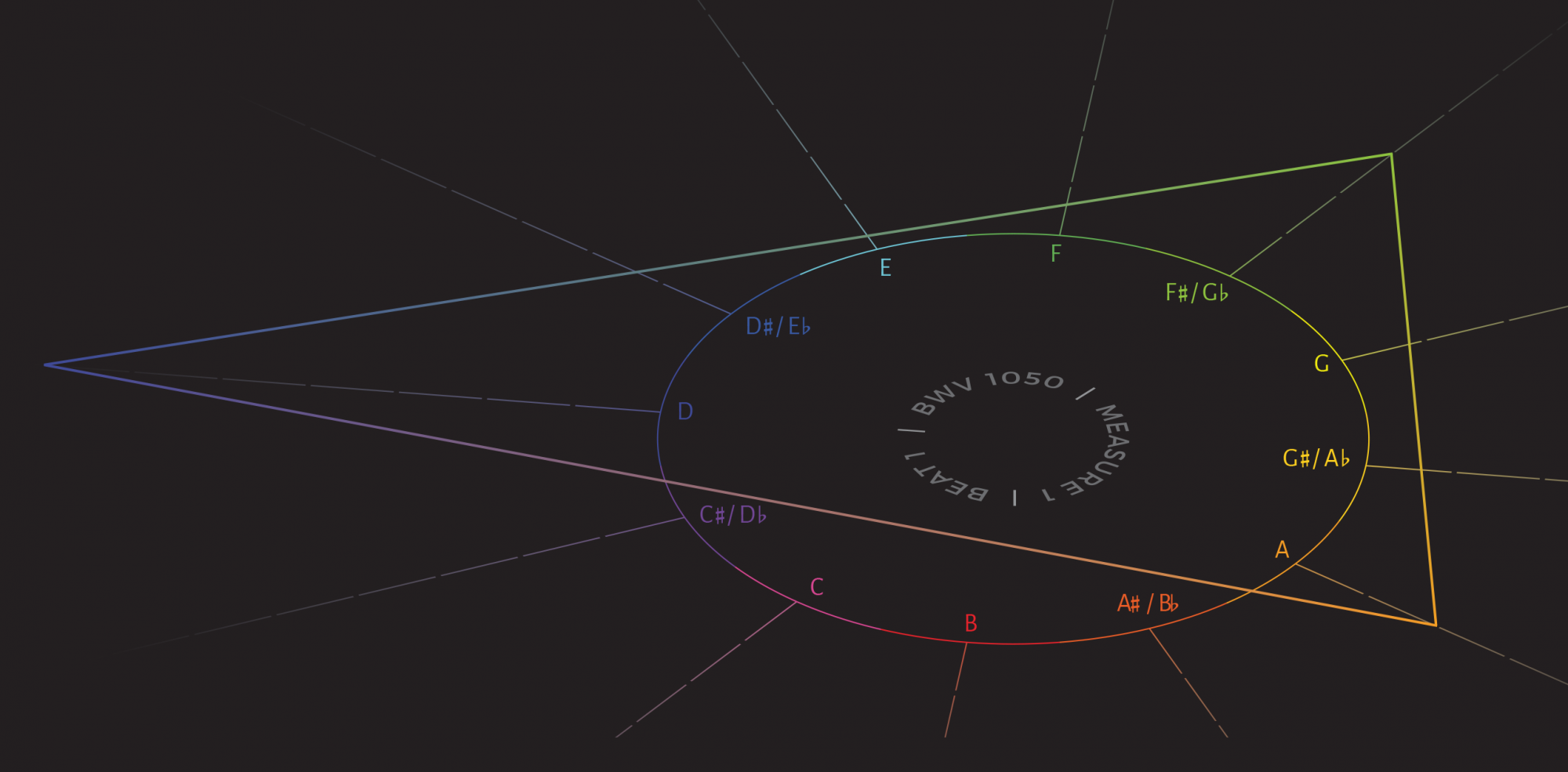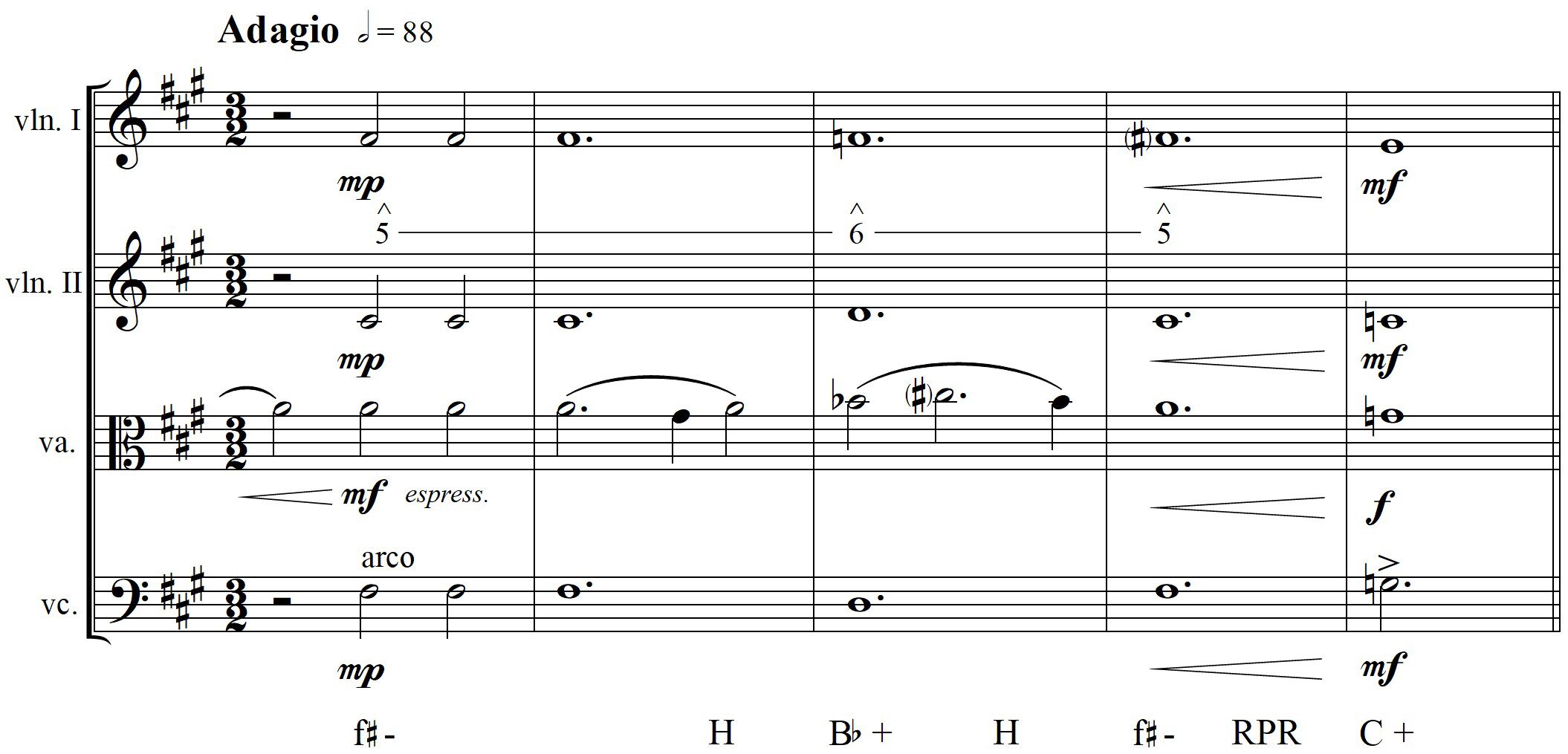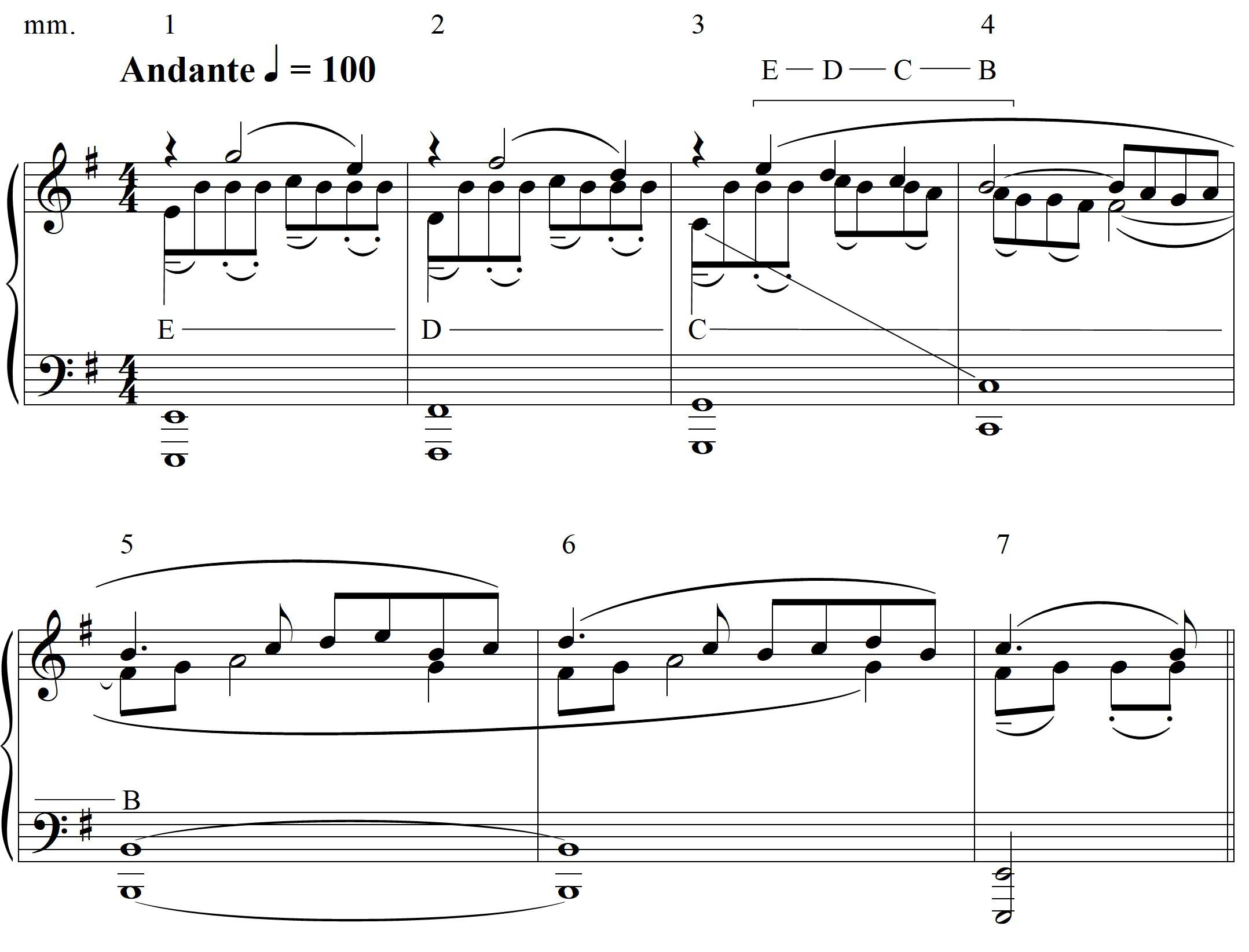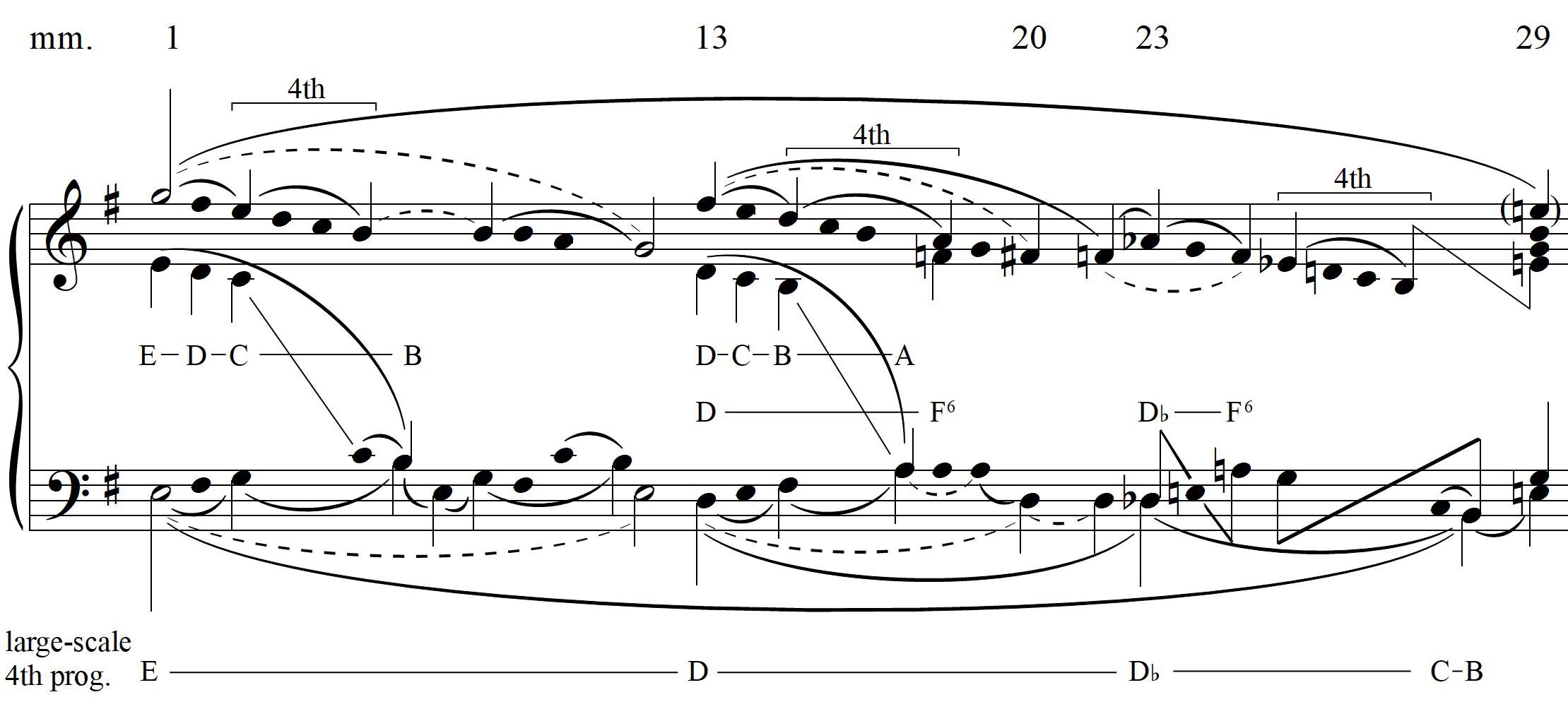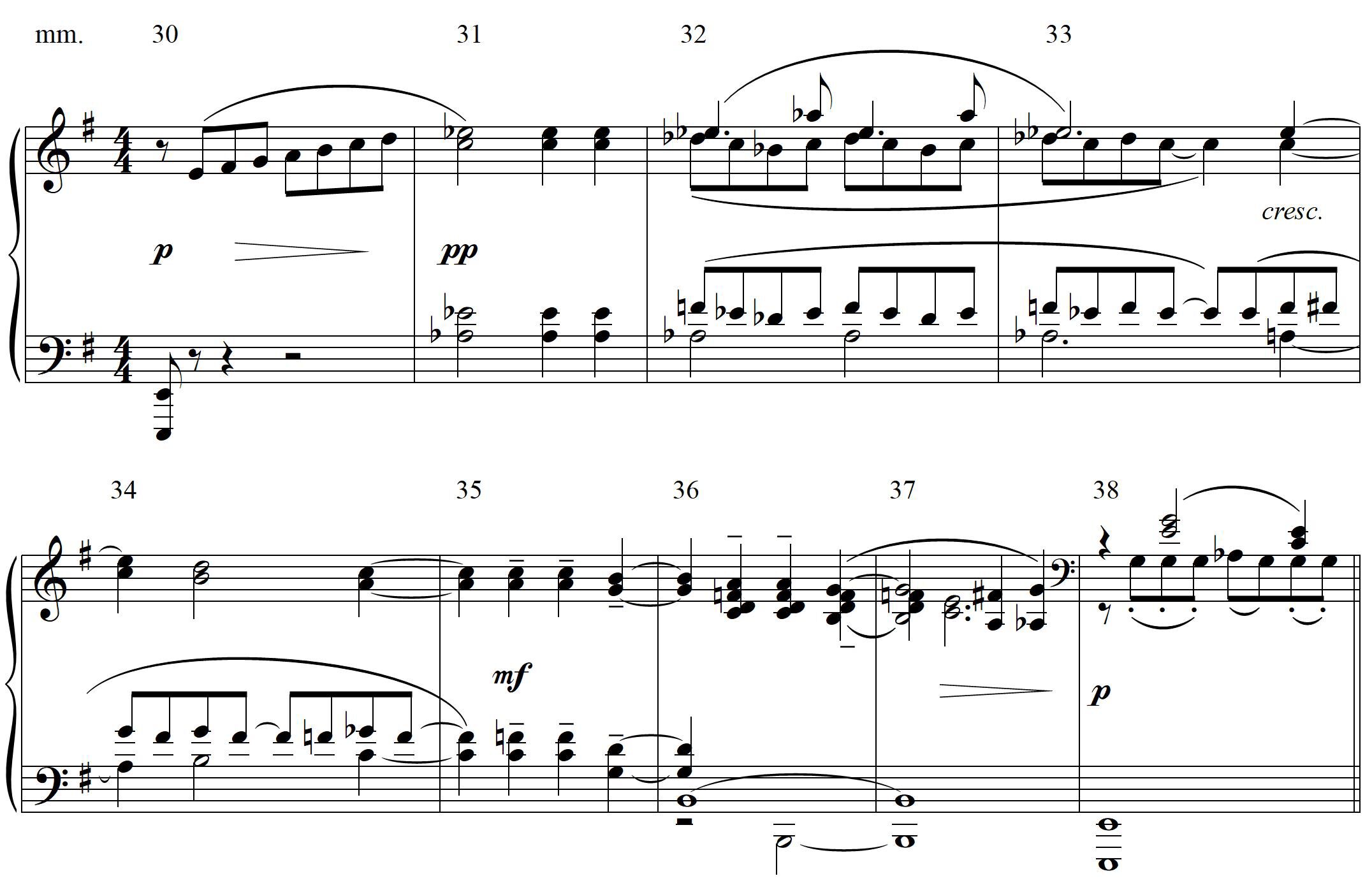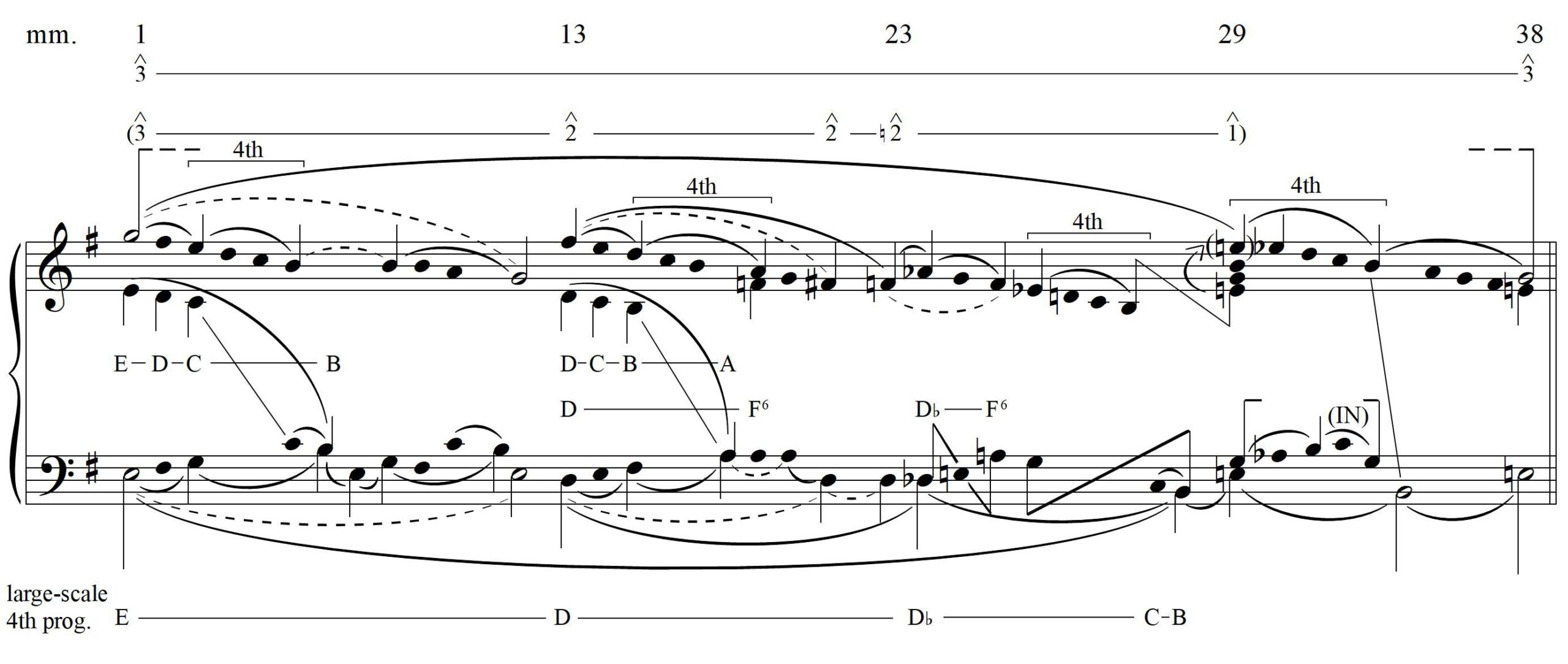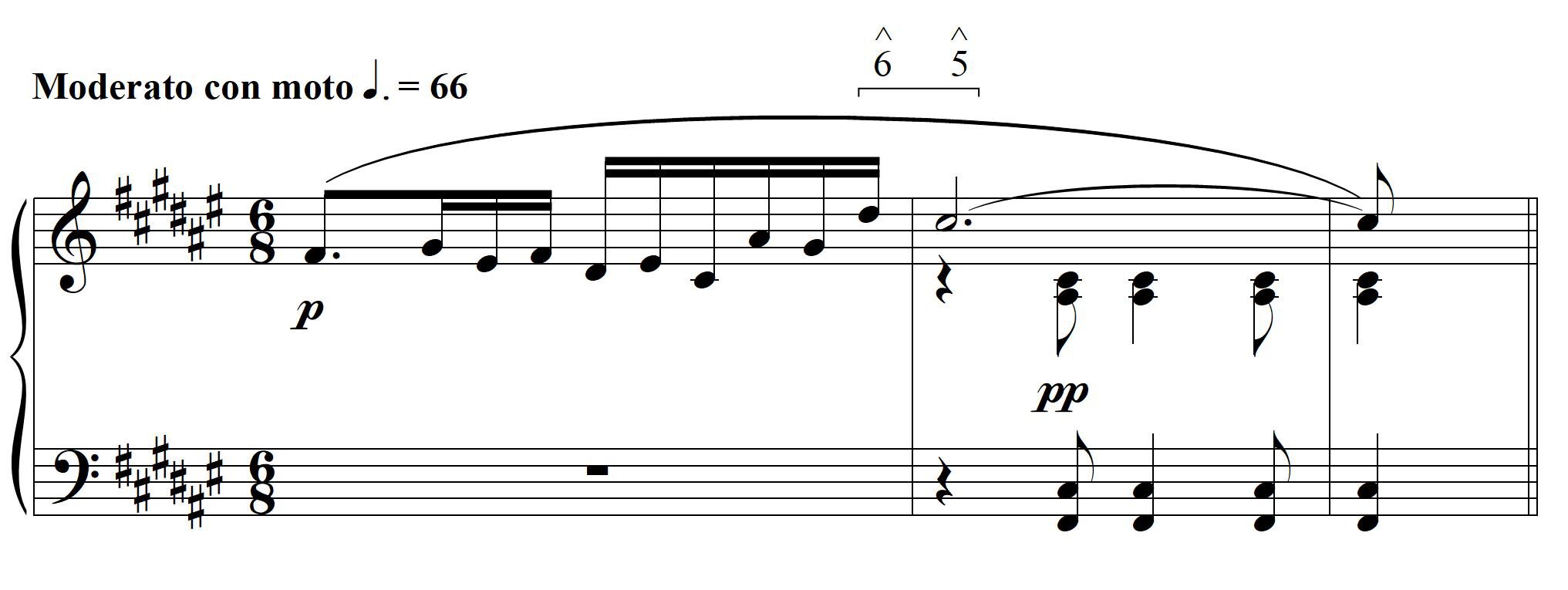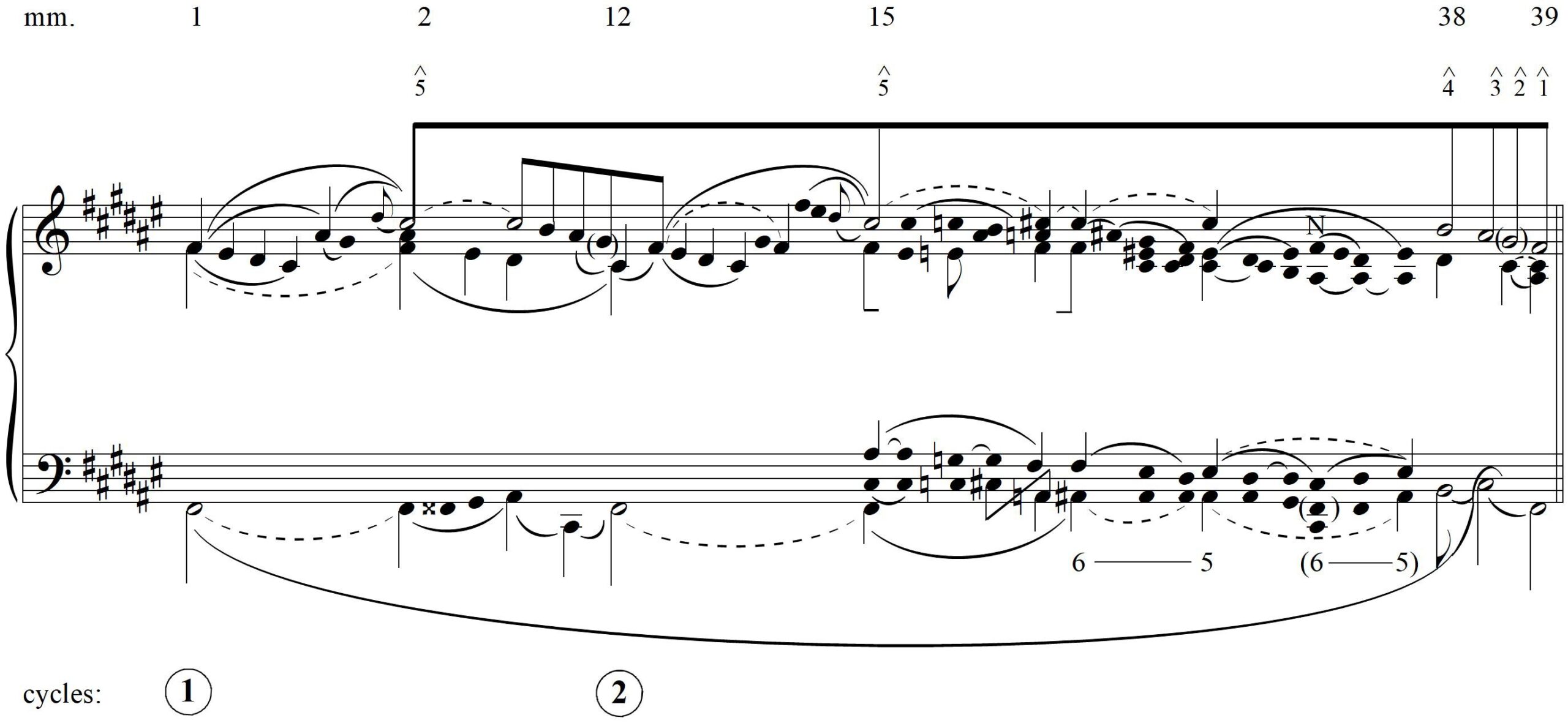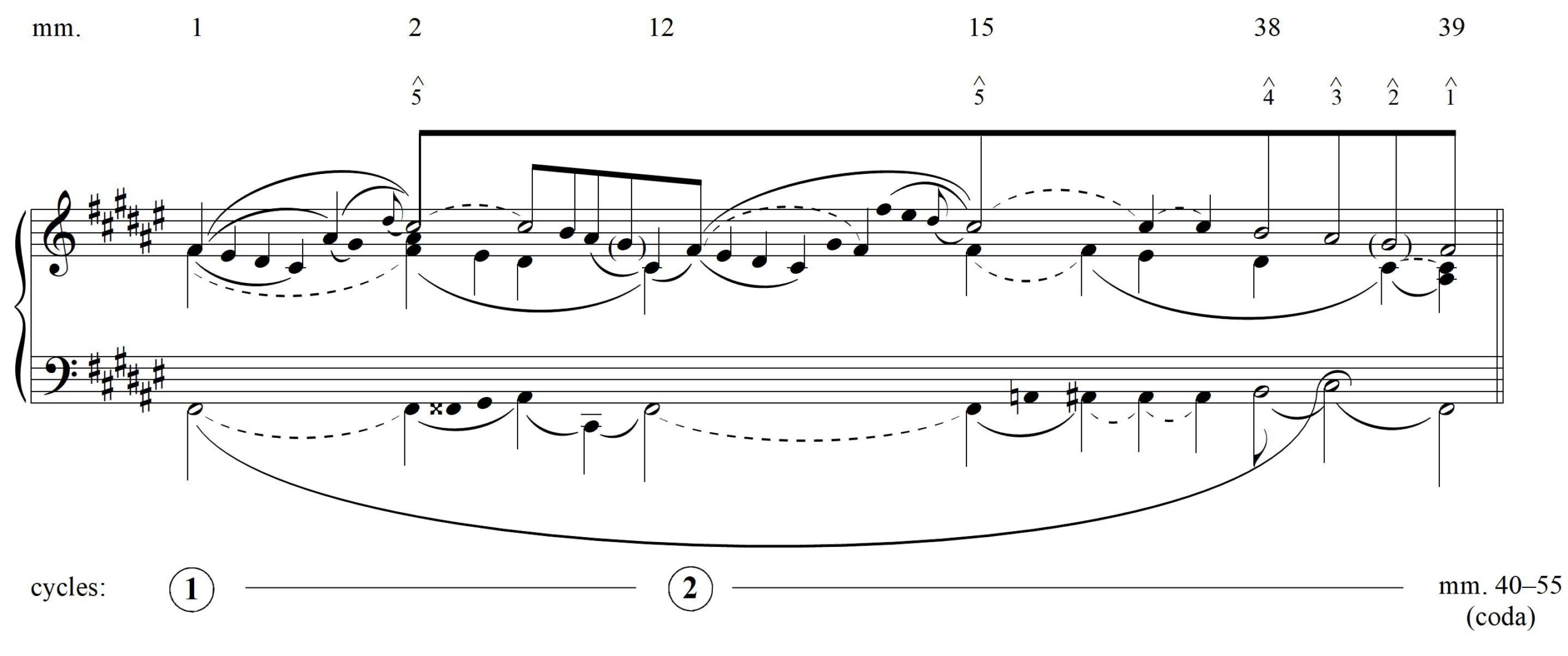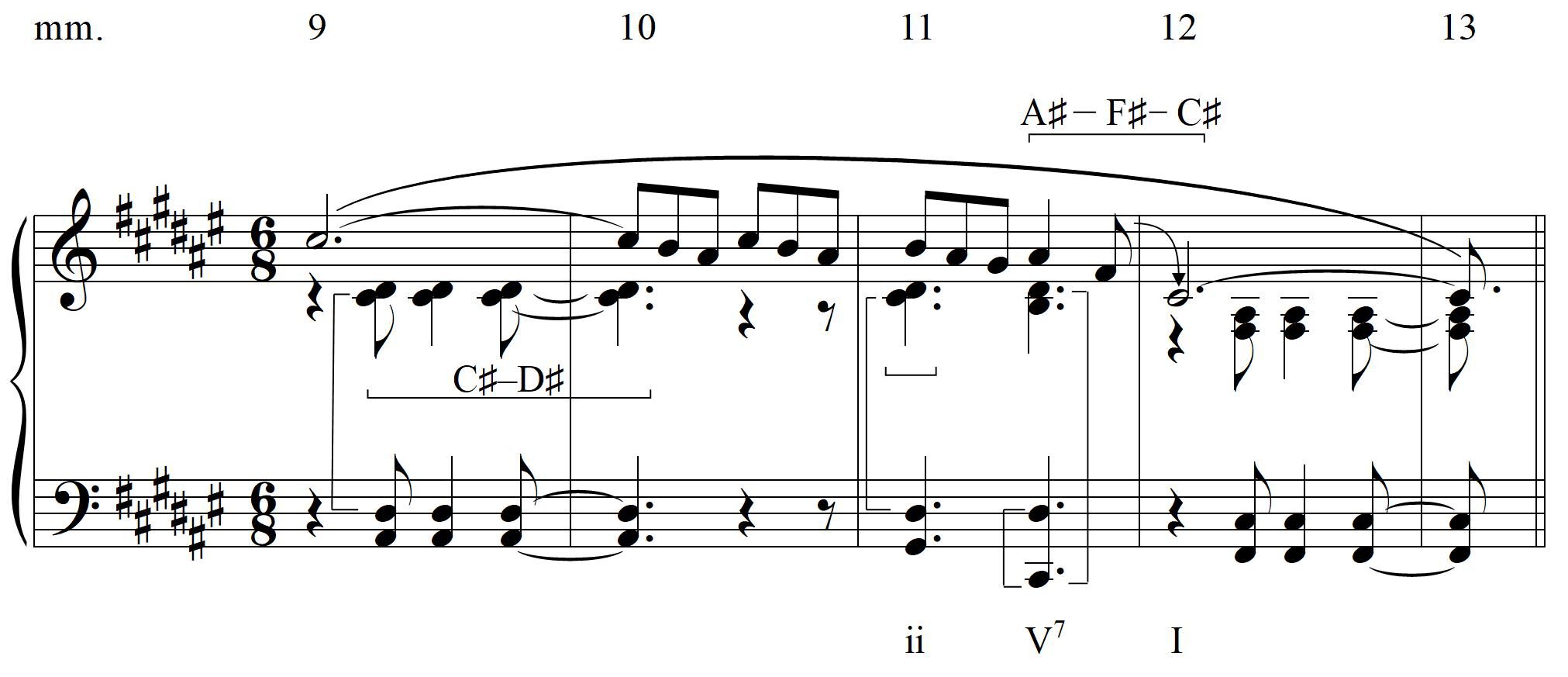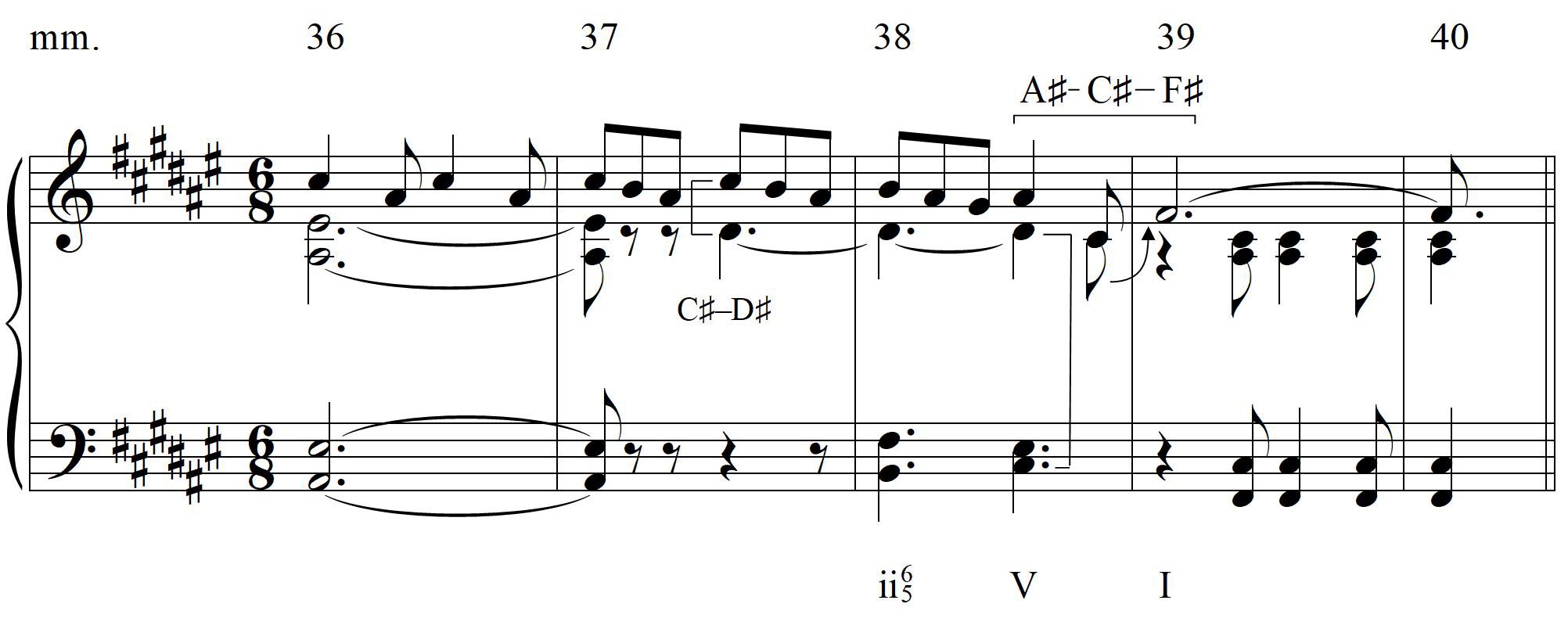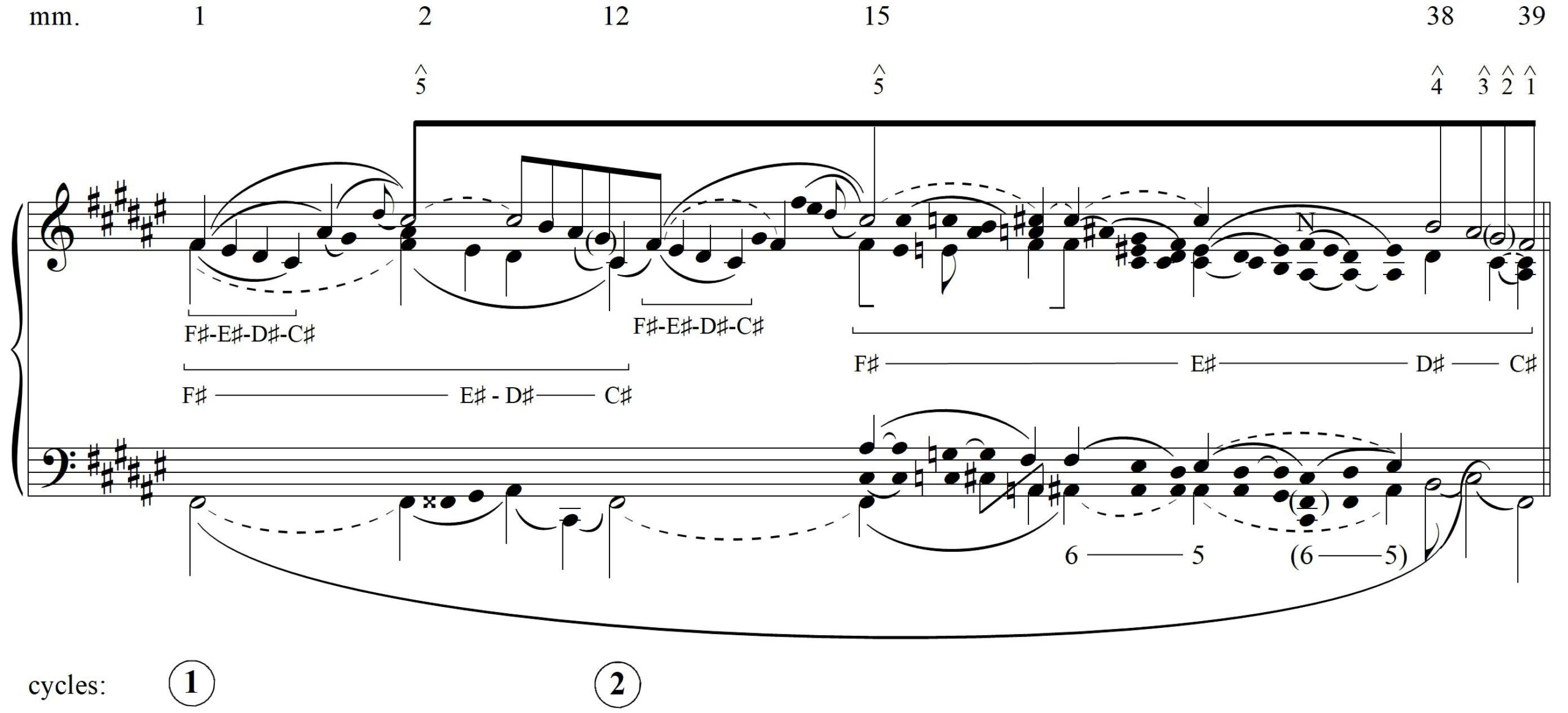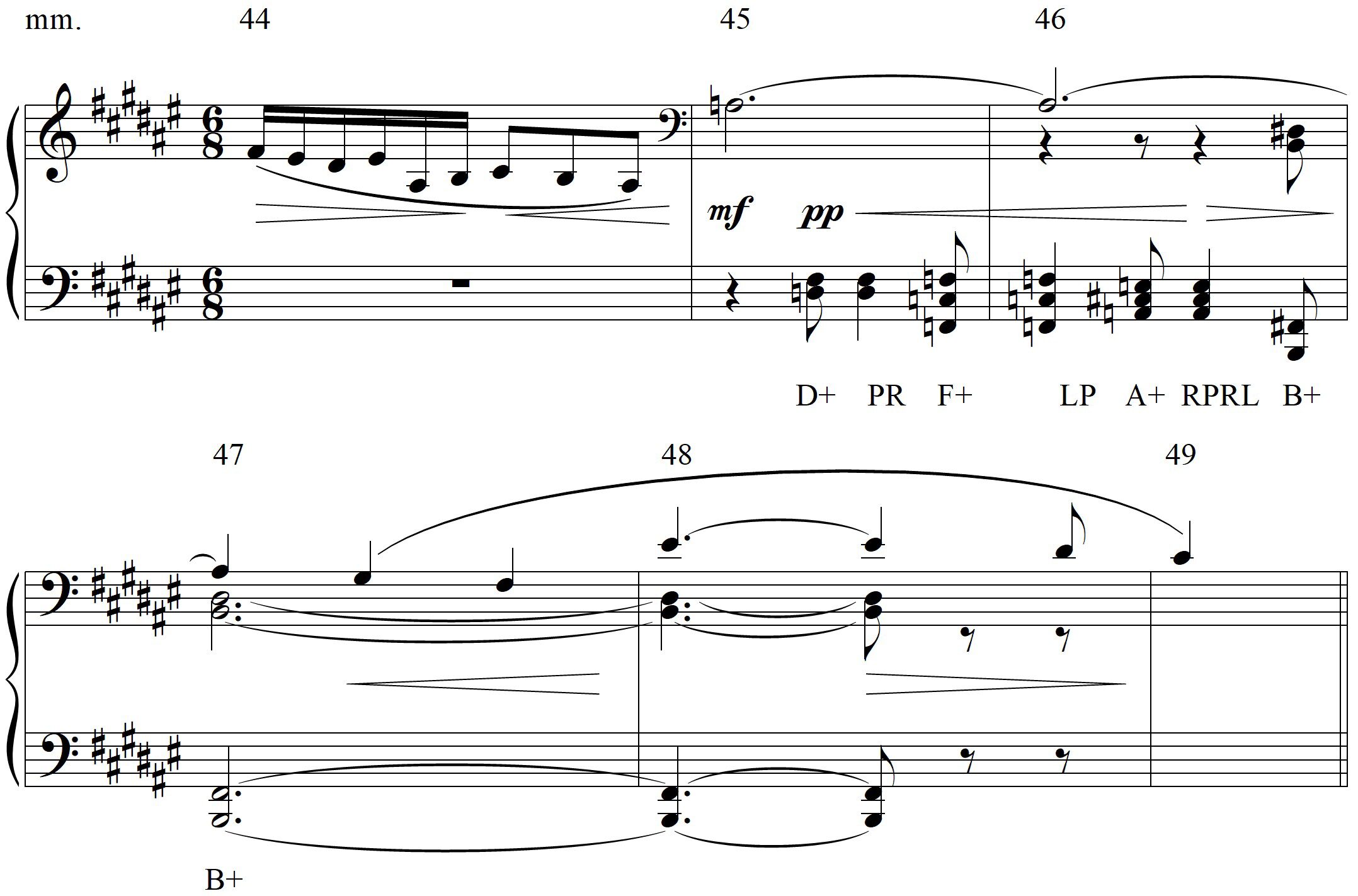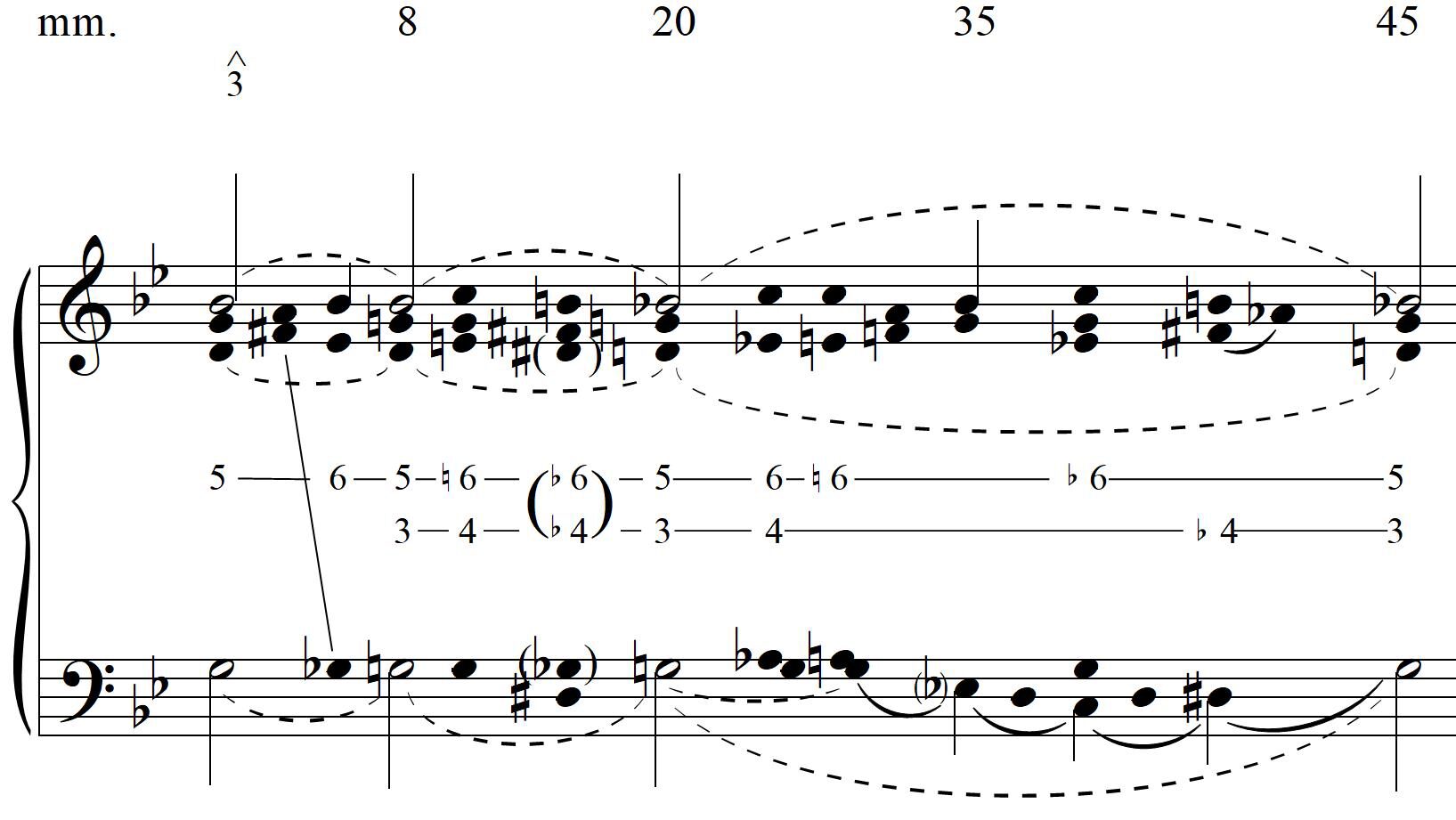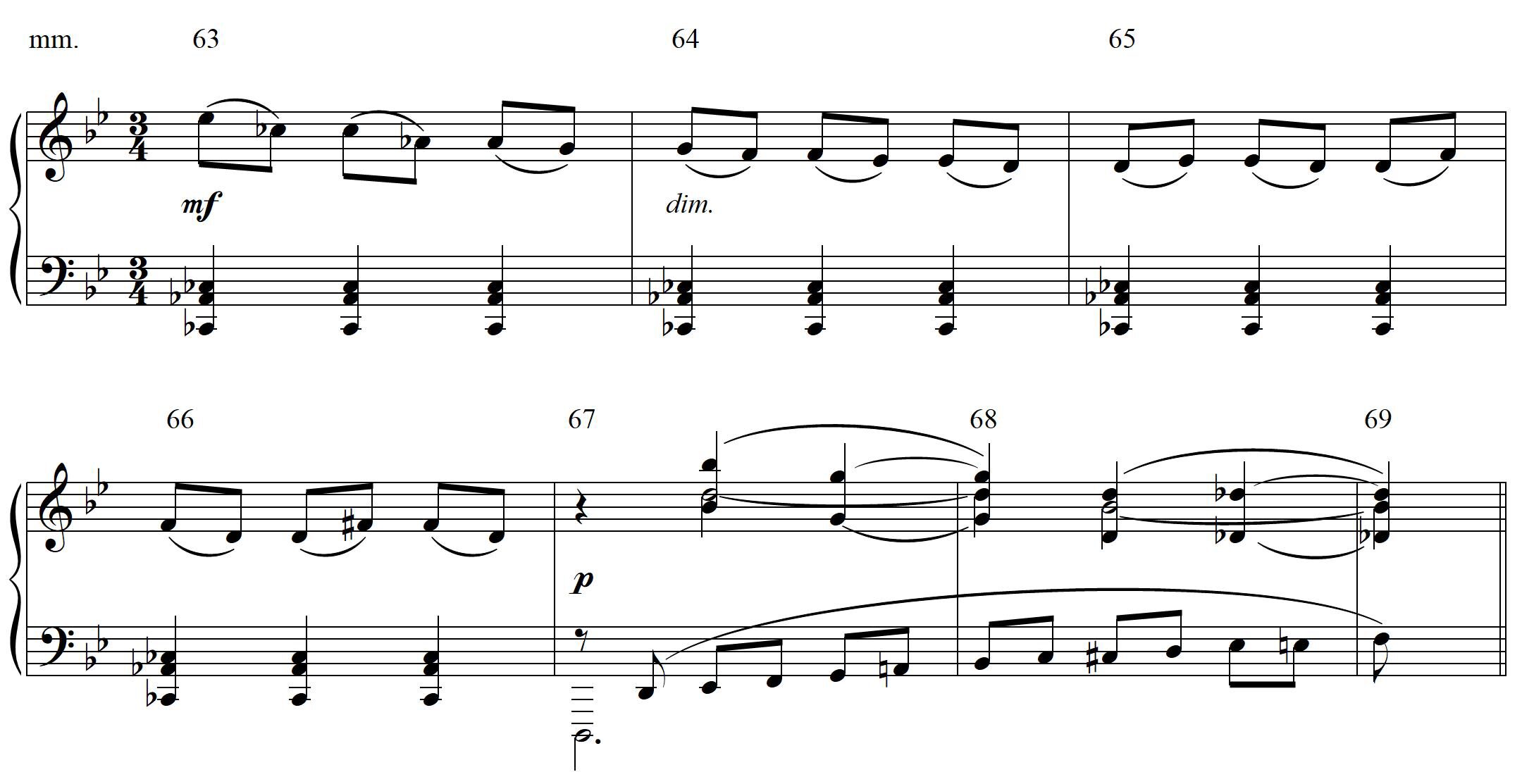Trevor C. Hofelich
Abstract
Schenkerian views of mixture and counterpoint address a wide range of chromatic activity in Dmitri Shostakovich’s monotonal works. Emulating contrapuntal procedures in Johann Sebastian Bach’s Well-Tempered Clavier, preludes in Shostakovich’s Twenty-Four Preludes and Fugues, op. 87 (1950–1951) are especially amenable to linear analysis. Not only do the op. 87 preludes exhibit functional states, but they also express Shostakovich’s meta-compositional musing on Baroque preludes. Although tonal operations are obscured by surface-level chromaticism, linear analyses of Prelude nos. 4, 13, and 22 contextualize post-tonal passages within broader tonal structures. Middleground examinations clarify how Shostakovich chromatically intensifies contrapuntal idioms without dismantling the function of impacted harmonies. This study expands on the work of David Fanning (2010) and Sarah Marlowe (2013), rendering models for structural hearing in Shostakovich’s music while considering how post-tonal harmonies are produced when diatonic elements are modally lowered.
View PDF
Return to Volume 38
Keywords and Phrases: Shostakovich, prolongational analysis, neo-Riemannian theory, Russian modal theory, triadic post-tonality, linear chromaticism
A tonal approach to Dmitri Shostakovich’s concert music must inevitably confront its post-tonal qualities. His melodic-harmonic language, situated between late nineteenth-century Romanticism and twentieth-century modernism, stretches the surface boundaries of tonality toward modal, chromatic, and triadic post-tonal spaces. Both Russian and Western scholars have examined the relationship between tonal, modal, and chromatic spaces in Shostakovich’s works, but few studies have explored the linear organization and functionality of these spaces from a prolongational perspective. Research by David Fanning (2010) and Sarah Marlowe (2013) demonstrates the capacity for prolongational methodologies to elucidate tonal processes in Shostakovich’s music.1 Expanding on these approaches, this study addresses a prominent gap in Shostakovich studies, prioritizing large-scale tonal structures in three preludes from the Twenty-Four Preludes and Fugues, op. 87 (1950–1951) through the contextualization of chromatic and modally derived scalar systems within broader functional frameworks.
Schenkerian views of mixture and tonicization account for a large variety of chromatic activity in monotonal works.2 While much of Shostakovich’s music resembles the late-Romantic tonal traditions of Pyotr Ilyich Tchaikovsky and Nikolai Rimsky-Korsakov, his post-tonal language expands the boundaries of functional triadic relationships. On the surface, distances between remotely related keys appear mitigated through linear chromaticism and triadic post-tonal voice leading (Hussey 2003). At deeper levels of structure, highly chromatic passages articulate the same functional states as the diatonic counterparts they intensify. The op. 87 preludes constitute a blend of conventional practice and reconstructions of tonality in triadic post-tonal spaces.3 They also express Shostakovich’s meta-compositional musing on Baroque preludes, especially those in Johann Sebastian Bach’s Well-Tempered Clavier (WTC), emulating Rule of the Octave patterns and idiomatic octave descents in their first cycles that expand a single harmony. Tonal procedures are obscured by triadic post-tonality and modal lowering on the surface; however, the following analyses of Prelude nos. 4, 13, and 22 from the Twenty-Four Preludes and Fugues contextualize these post-tonal intensifications within broader middleground structures. Considering mixture and counterpoint in each prelude elucidates how the music establishes a harmonic state and generates motion toward a tonal goal. This study also considers how chromatic harmonies in each prelude are produced when their diatonic elements are modally lowered.
1. Reconstruction of Tonality
Shostakovich’s emulation of Baroque prelude practice in the Twenty-Four Preludes and Fugues provides many access points for prolongational analysis. To prepare for the following discussions of structural hearing in the preludes, it is important to examine these access points within the context of reconstructed tonal models in Shostakovich’s post-1936 works, integration of Baroque idioms in the op. 87 preludes and meta-compositional references to Bach’s WTC, and broader linear and transformational approaches to post-tonal voice leading. In the discussion of this final concern, the opening thematic statement of Shostakovich’s String Quartet no. 9 in E$$\flat$$ Major, op. 117, II (1964) is used as a characteristic model of hexatonic prolongation.
While his post-1936 works are responsive to linear approaches due to the rehabilitation of more traditional tonal practices into his music following the Pravda attacks on his opera Lady Macbeth of the Mtsensk District, op. 29 (1930–1932; later revised as op. 114) and ballet The Limpid Stream, op. 39 (1934–1935), the Twenty-Four Preludes and Fugues are remarkably approachable due to the context in which they were composed.4 In the two years following his denunciation by Andreĭ Aleksandrovich Zhdanov in 1948, Shostakovich severely shifted his compositional ideology in response to his endangered career; this shift has not been discussed to the same extent as his first Marxist transition in 1936. Richard Taruskin acknowledges the Twenty-Four Preludes and Fugues as being a product of Shostakovich looking back through time for a form of stylistic neutrality to remedy his “formalism”—a pill to purge Stalinism. He states, “Shostakovich’s imagined Bach was a consoling pastor who could lead him beside the still waters and restore his soul. Buffeted by the world in its games of power as no mere composer had ever been, Shostakovich was desperately seeking a neutral corner” (Taruskin 2008, 332).
The Twenty-Four Preludes and Fugues exemplify Baroque practices of prelude and fugal composition, including tonal and contrapuntal idioms that generate harmonic states or motion toward tonal goals. Like Frédéric Chopin’s 24 Preludes, op. 28 (1839), these pieces traverse all major and minor keys and stylistically emulate Bach’s WTC.5 Shostakovich’s preludes and fugues often incorporate meta-compositional references that directly acknowledge features of specific pieces in the WTC. Before examining larger musical contexts, it is important to establish how the Twenty-Four Preludes and Fugues confirms its association with the WTC.
Intertextuality is a frequent technique featured in Shostakovich’s music. While quotation and self-quotation have been studied in his symphonies and chamber works, more subtle references and musical impersonations of Bach take place in the Twenty-Four Preludes and Fugues. Examples 1a and 1b illustrate several ways in which Shostakovich musically acknowledges preludes and fugues fromthe WTC. Example 1a presents the first measure from both Shostakovich’s Prelude no. 1 in C major and Bach’s Prelude in C major from Book I.
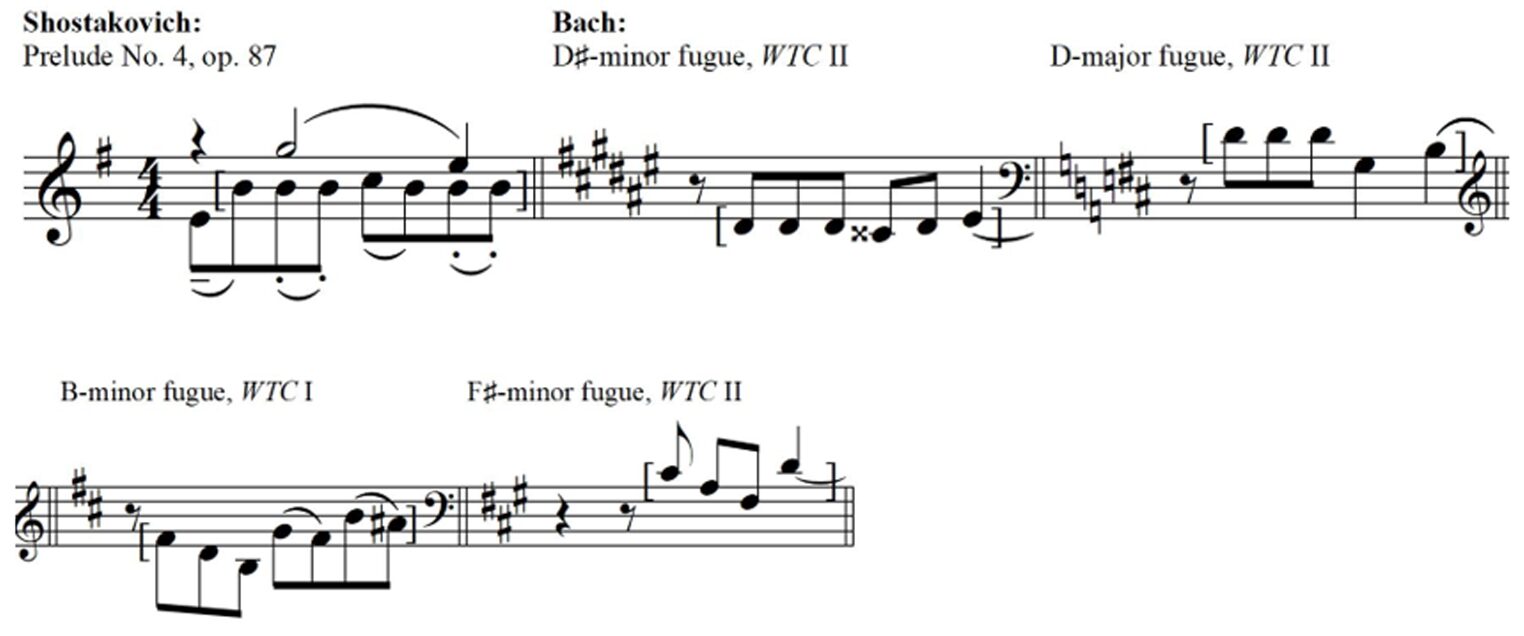
Taruskin observes that Shostakovich’s first prelude “invokes the Bachian muse, as if seeking its protection: a gentle sarabande, it begins with a chord made up of exactly the same notes that Bach had presented as an arpeggio in his opening prelude” (Taruskin 2008, 332). Lyn Henderson observes further connections to Baroque practice in Shostakovich’s preludes and fugues. She writes,
The music, though rarely approaching pastiche, shows a felicitous response to eighteenth-century models. The B minor prelude’s heavily dotted rhythms, for example, suggest the French overture and Bach’s citing of it in his D major fugue. The C$$\sharp$$ minor prelude recalls Bach’s E$$\flat$$ major prelude in its busy thematic patterning. The standard dance movements of the baroque suite prompted a variety of stylisations, notably the C major and F major preludes, echoing the rhythm of the sarabande, the D and D$$\flat$$major preludes, suggesting the minuet, and the B major prelude evoking the gavotte. In several examples, fugal discipline would appear to have fostered a corresponding restraint of harmonic idiom, as in the white-note idiom of the B$$\flat$$ minor fugue. Other examples include the strongly tonal subject and diatonic working-out, with canon, of the E major fugue, the gigue-like G major fugue, and the fugue in E$$\flat$$ minor, which submits unconditionally to the demands of baroque syntax. (Henderson 2000, 55)
Example 1b suggests additional rhythmic correlations between the opening of Shostakovich’s Prelude no. 4 in E minor and four fugues from the WTC. The bracketed rhythmic articulations in the first measure of Shostakovich’s E-minor prelude and the beginning of subjects in Bach’s fugues (D$$\sharp$$ minor from Book II, D major from Book II, B minor from Book I, and F$$\sharp$$ minor from Book II) convey similar rhythmic gestures, where a succession of shorter note values is followed by a longer gesture (a quarter note or two short notes slurred together). Shostakovich’s musical connections to Bach and the Baroque style confirm that the op. 87 preludes are rooted in customary frameworks.
In addition to associations with the Baroque style,the op. 87 preludes enable further access points for linear analysis through Shostakovich’s use of hexatonic progressions that function as chromatic analogues to more traditional prolongational idioms. Hexatonic relationships are commonplace in Shostakovich’s music, producing triadic post-tonal harmonies that are related through motion between chromatic poles. A prominent example of these relationships can be observed in the opening measures of the second movement of String Quartet no. 9 in E$$\flat$$ Major, op. 117 (1964). In mm. 1–5, parsimonious voice leading connects F$$\sharp$$-minor triads (tonic) to B$$\flat$$-major and C-major triads (see Example 2).
Although neighboring or passing motions via chromatic poles have not been widely explored as expressing functional states in Shostakovich’s music, Schenker’s theory places no limit on the degree of chromaticism in tonal contexts.6 He explains, “A firmly established tonality can guide even a large number of chromatic phenomena securely back into the basic triad” (Schenker 1977, xxiii). Furthermore, hexatonic and tritone poles in this movement are generated from the chromatic lowering of the F$$\sharp$$-minor scale and do not obscure the movement’s monotonality at the surface level.
Measures 1–4 present six notes, each of which belongs either to the F$$\sharp$$-minor or B$$\flat$$-major triad (not counting the G$$\sharp$$ in the viola melody in m. 2, which neighbors A). These pitches form a hexatonic set of major and minor triads: F$$\sharp$$-, F$$\sharp$$+, B$$\flat$$-, B$$\flat$$+, D-, and D+. In the hexatonic cycle, navigation from F$$\sharp$$ minor to B$$\flat$$ major is facilitated by neo-Riemannian transformation H (also understood as PLP or LPL), as shown in Example 3.7 H transformations divide hexatonic space symmetrically and produce neighboring motions, but these progressions have not been explored as prolonging harmonic states in Shostakovich’s music.
Example 3 proposes that F$$\sharp$$ minor is expanded by its hexatonic pole through neo-Riemannian transformations. The extension of F$$\sharp$$ minor across mm. 1–4 is produced by semitone voice leading in hexatonic space analogous to a contrapuntal $$\hat{5}$$–$$\hat{6}$$–$$\hat{5}$$ above tonic. In addition to the $$\hat{5}$$–$$\hat{6}$$–$$\hat{5}$$ motion in the upper voice, every voice moves by one semitone to form the B$$\flat$$-major triad.
In tonal music, prolongation via $$\hat{5}$$–$$\hat{6}$$–$$\hat{5}$$ typically preserves at least one common tone between chords. While no common tones are shared between the chords in mm. 1–4, the $$\hat{5}$$–$$\hat{6}$$–$$\hat{5}$$ idiom is present in the second violin (C$$\sharp$$–D–C$$\sharp$$). The progressions in Example 4a illustrate comparable diatonic neighboring motions, suggesting that the B$$\flat$$-major triad is a chromatically altered version of a neighboring chord or a voice-leading chord. The progression with vii$$^{\circ}$$7 serves as an alternative point for comparison, as it provides a more inclusive illustration of the pitches used in mm. 1–4 (D, and F$$\natural$$ as

Alternatively, Example 4b demonstrates how
While double mixture contextualizes B$$\flat$$ major as an enharmonic chromatic mediant that produces the $$\hat{5}$$–$$\hat{6}$$–$$\hat{5}$$ idiom, further examination of the pitches in mm. 1–4 reveals one of Alexander Dolzhansky’s scalar variants. Pitches F$$\sharp$$–G$$\sharp$$–A–B$$\flat$$–C$$\sharp$$–D–(E)–F$$\natural$$ form the double-lowered Aeolian scale, one of the most common modally derived scales in Shostakovich’s music.10 While E is absent from mm. 1–4, the most salient features of this scale are expressed in the viola’s theme. The chromatic neighboring of G$$\sharp$$ and B$$\flat$$ around A articulates the scale’s two adjacent half steps between $$\hat{2}$$–$$\hat{3}$$ and $$\hat{3}$$–$$\flat\hat{4}$$ followed by a leap of an augmented second between $$\flat\hat{4}$$–$$\hat{5}$$. The lowered scale degrees generate triadic post-tonal harmonies such as B$$\flat$$ major when $$\flat\hat{4}$$, $$\hat{6}$$, and $$\flat\hat{8}$$ of the double-lowered Aeolian scale vertically converge.11
Though this Russian modal scale accounts for chromatic activity that forms the $$\hat{5}$$–$$\hat{6}$$–$$\hat{5}$$ idiom, it does not explain how the harmonic state of F$$\sharp$$ minor occupies the space of mm. 1–4. The process of double mixture, however, describes how a chromatically altered mediant harmony both prolongs the tonic Stufe and establishes a contrapuntal idiom not usually associated with the mediant. In tonal music, harmonic motion between tonic and mediant tends to sound more like an expansion of tonic than a progression of two harmonies. While III can function as a tonic substitute or expansion, it generally does not participate in the progression i–III–i in the manner of prolongational idioms such as i–V–i or i–iv–i. When the tonic progresses to the mediant, the mediant is usually followed by a pre-dominant harmony that connects to V, completing the arpeggiation of the tonic triad. The mixture mediant $$\sharp$$III, however, enharmonically contextualizes $$\sharp\hat{3}$$ and $$\sharp\hat{5}$$ as $$\flat\hat{4}$$ and $$\hat{6}$$, operating within Shostakovich’s modally lowered scale. Though the mediant is chromatically altered in this passage, the prolongational span of tonic is produced by the harmonic and contrapuntal activity of mm. 1–4. Schenker’s theory explains that chromatic Stufen retain the functional behaviors of their diatonic counterpoints. He states,
In its chromatic state, the Stufe proves itself to be the same spiritual and higher unity that we have already defined for the diatonic form; the obligation to return to the diatonic system does not imply any restrictions as far as the duration of the chromatic Stufe is concerned; its duration remains variable just like that of the diatonic Stufe and varies from a minimum to the greatest conceivable maximum. (Brown 1986, 14)
In Schenker’s system, all triads are effectively created from and are related to the tonic triad using harmonic principles, meaning that this system is transformational. Therefore, chromatic and modal inflections are also understood in relation to the tonal system or the tonic triad. Chromatic Stufen “do not elaborate or substitute for diatonic Stufen,” but are “alternative ways of expressing the same harmonic state” subject to the same types of prolongation as their diatonic counterparts (Brown 1986, 14). Additionally, Schenker did not distinguish between classical diatonic tonality and nineteenth-century chromatic tonality when developing his tonal system. He “conceived of one and only one system of tonal relations” (Brown 1986, 14).
Triadic post-tonality in Shostakovich’s music not only expresses functionality through the processes of simple, secondary, and double mixture, but also through contrapuntal motions that expand harmonic states and form directed motion toward tonal goals.12 Contrapuntal processes have provided access points to prolongational techniques in a wide selection of post-tonal repertoire, including music composed by Shostakovich (Fanning 2010; Marlowe 2013), as well as concerns with post-tonal prolongation more generally (Baker 1990; Brown 1993; Bakulina 2015, 2018; Salzer 1952; Forrest 2010; Jackson 2024). These analyses exemplify how voice-leading methodologies approach and contextualize linear content in pieces that exhibit contrapuntal procedures analogous to canonic monotonal literature by twentieth-century composers. While post-tonal environments engender fewer functional relationships between harmonies or pitch-class sets, James Baker discloses how Schenkerian analysis illuminates aspects of structure in post-tonal music that other methodologies such as set theory or neo-Riemannian analysis cannot. Like Russian modal theories, set theory and other transformational approaches elucidate surface tendencies in chromatic music, but do not typically address large-scale organization.13 Prolongational tools, however, can display how post-tonal music expresses different states of linearity at multiple levels of structure without forcing the music into standard tonal models. Prolongational techniques also shed light on how twentieth-century works produce long-range structure and motivic confirmation.14 When considering linear approaches to post-tonal works, Baker advises, “It is my conviction that the important question concerning a composition on the borderline between tonality and atonality is not: Is it tonal or atonal? Rather, one must ask: In what way is this piece tonal?” (1990, 168). Though Baker does not advocate for prolongational analysis as a primary methodology, he asserts that Schenker’s theory can be a useful component in a comprehensive approach to twentieth-century music.
An analytical thread between studies by Sarah Marlowe, David Fanning, James Baker, Matthew Brown, and Felix Salzer illustrates how linear counterpoint produces harmonic states in post-tonal music, albeit in less functional manners than in common-practice works. Voice exchanges, for example, can establish a harmonic state sustained via passing tones. While the prolongation of a set class is problematic yet conceptually valid in Baker’s view, harmonic states in Shostakovich’s music are produced through contrapuntal techniques analogous to music in the Bach-to-Brahms canon (Fanning 2010, 78–79). Fanning (1989, 1995, 2010) has written voluminously on the music of Shostakovich and how linear progressions generate the processive forces behind harmonic and motivic development in the symphonies. Marlowe (2013, 103–188), similarly, explores Schenkerian applications to fugues from the Twenty-Four Preludes and Fugues, op. 87 and addresses interactions between Schenkerian theory and Russian modal theory. Her work, perhaps the most extensive answer to Ellon Carpenter’s call for all-inclusive approaches to Shostakovich’s music, engages with the foreground and middleground structures of Fugue nos. 22 and 23.15 Marlowe’s study underscores the ability of Schenker’s theory to accommodate Shostakovich’s surface chromaticism and addresses a significant gap in linear approaches to his music for solo piano. This study expands on the work of Fanning and Marlowe, answering Carpenter’s call for large-scale processive analyses of Shostakovich’s music. The following analyses investigate Shostakovich’s reconstructed expressions of tonality in the op. 87 preludes and explore his rhetorical associations with Bach’s WTC.
2. Prelude No. 4 in E Minor, Op. 87
A linear approach to the op. 87 preludes addresses prominent long-range connections and elements of their tonal architecture. Each prelude examined in this study features two cycles of thematic material, post-tonal analogues to prolongational gestures, and motivic confirmation. Prelude no. 4, like preludes in the WTC, presents two cycles of thematic material before its structural closure (see Example 5). The second cycle chromatically elaborates on diatonic material in the first cycle, typical of both Baroque preludes and other Baroque styles and dances (Lester 1999, 128). The prelude also incorporates a descending-fourth motive ($$\hat{1}$$–$$\hat{7}$$–$$\hat{6}$$–$$\hat{5}$$); this motive saturates the prelude’s foreground and middleground structures and prefigures a global harmonic progression that unfolds over both cycles. The modal lowering of the descending fourth in the second cycle chromatically displaces contrapuntal motions of previous diatonic passages.
Example 6 illustrates two stepwise descents outlining a fourth in mm. 1–7. The melody presents the descending fourth directly in mm. 3–4, and a broader version descends in an inner voice in mm. 1–5. The registral transfer of the inner voice from C4–C3 enables it to complete its descent from E4 in the bass register in mm. 3–4. Without considering registral transfer, the inner voice on C4 in m. 3 appears to vanish in m. 4. This interpretation traces the stepwise continuity of each voice from the falling thirds in the upper voice in mm. 1–2 to the overarching fourth motion in the inner voice. At a deeper level, each cycle exhibits a large-scale octave descent in the melody starting on different scale degrees ($$\hat{3}$$ in the first cycle followed by $$\hat{2}$$ in the second). Octave descents are characteristic of Baroque preludes when the bass steps downward from $$\hat{1}$$ to $$\hat{5}$$, then descends to $$\hat{1}$$ again, completing a scale within the first cycle.
Example 7 reproduces Schenker’s sketches of the C-major and C-minor preludes from the WTC, Book I (Schenker 1977, 77, fig. 95e 3–4). In each sketch, the melody follows the bass line in parallel tenths, completing octave descents within their first cycles.

William Renwick (1995, 11–15) also observes octave descents in Bach’s C-major, C-minor, D-major, and E-minor preludes from the WTC,Book I in his chapter on analyzing fugue, connecting the descents to Rule of the Octave patterns (see Examples 8a and 8b). Similarly, I analyze the octave descents in the first cycle of Bach’s E-minor prelude in Example 8c, illustrating the parallel tenths formed between the bass and melody that are rhythmically misaligned on the musical surface. Example 9, analogously, depicts how Shostakovich emulates the melodic octave descent in each cycle of Prelude no. 4 (Example 9 also preserves the descending fourths in the melody and inner voice). Resembling the linear pathways outlined in Examples 7, 8a, 8b, and 8c, the melody begins on $$\hat{3}$$ and traverses an octave descent by step. The only structural difference between Shostakovich’s prelude and Bach’s is that the bass does not descend with the melody in parallel tenths.
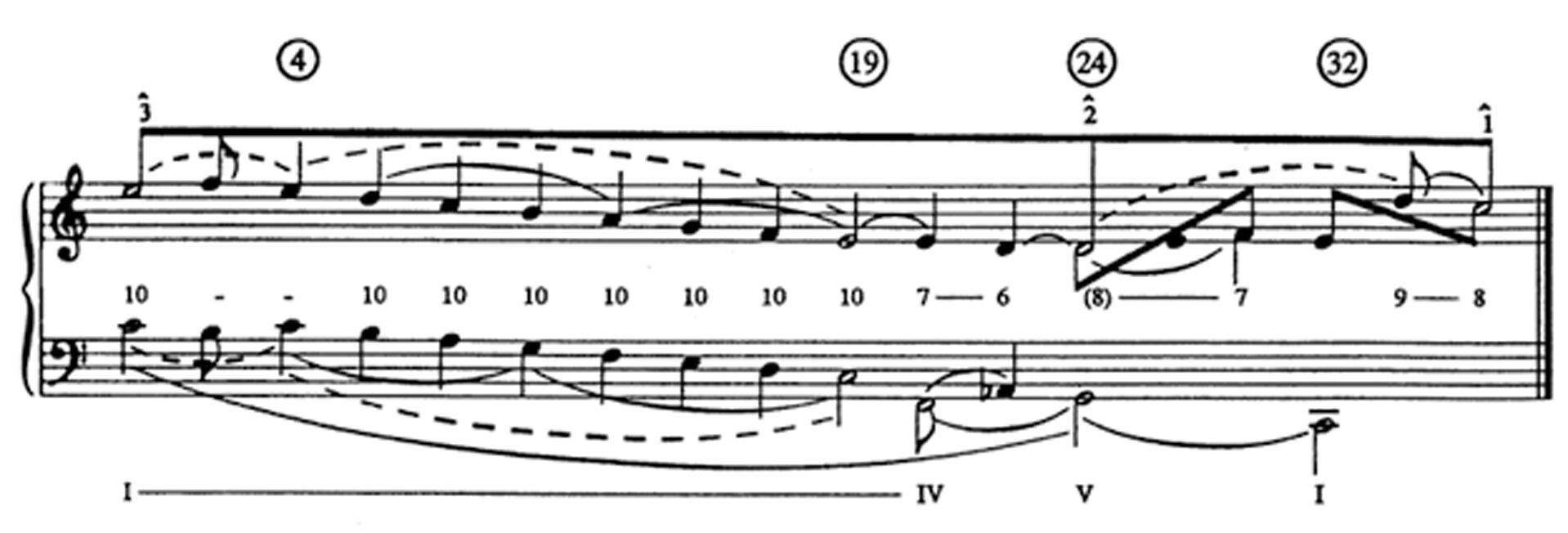
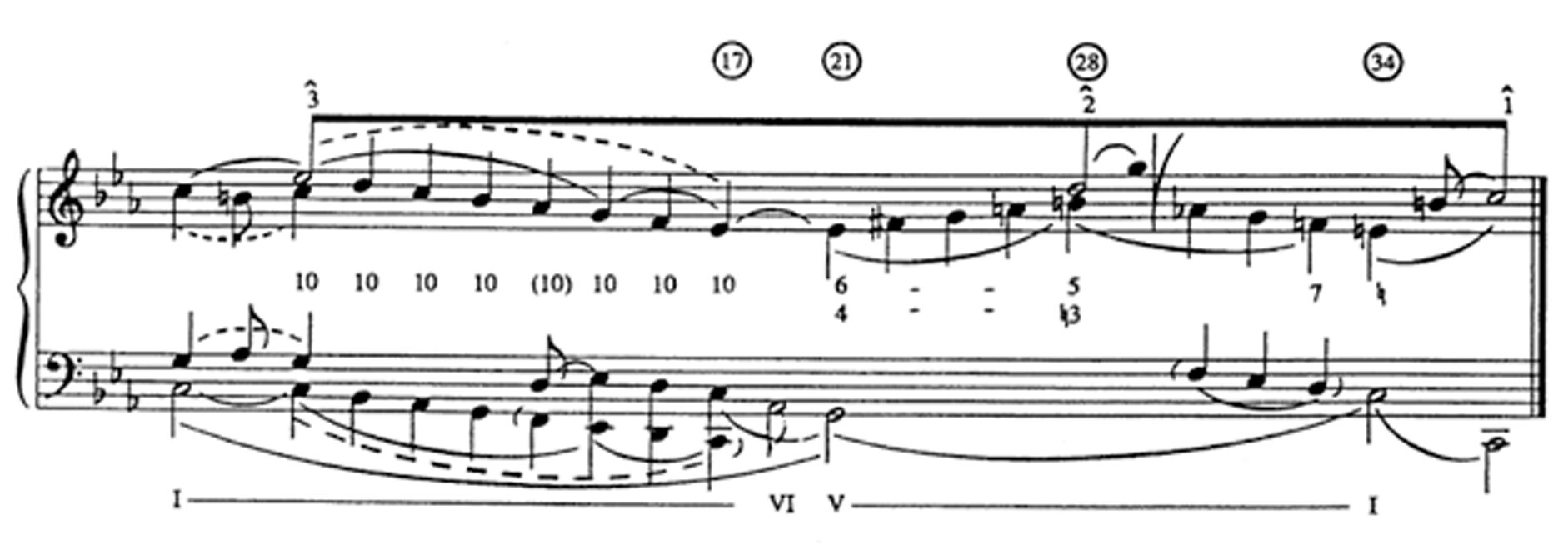
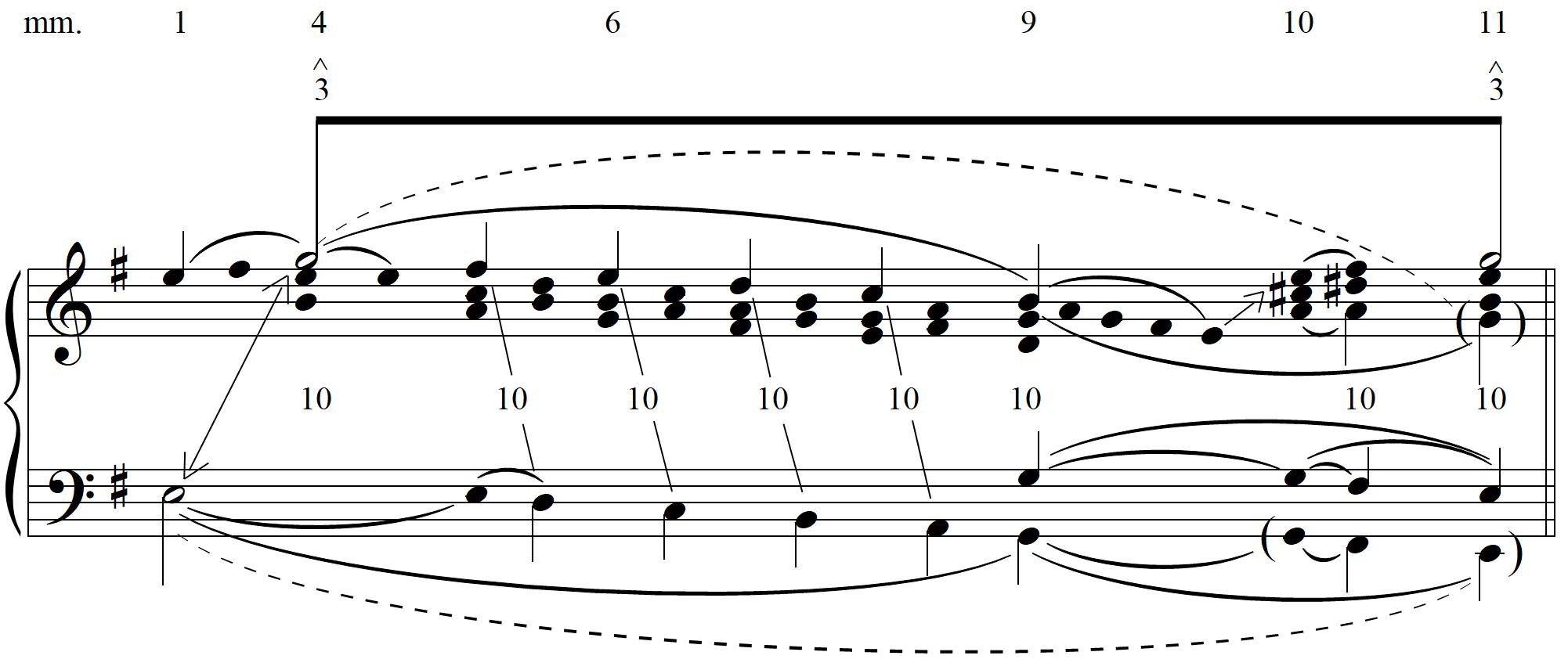
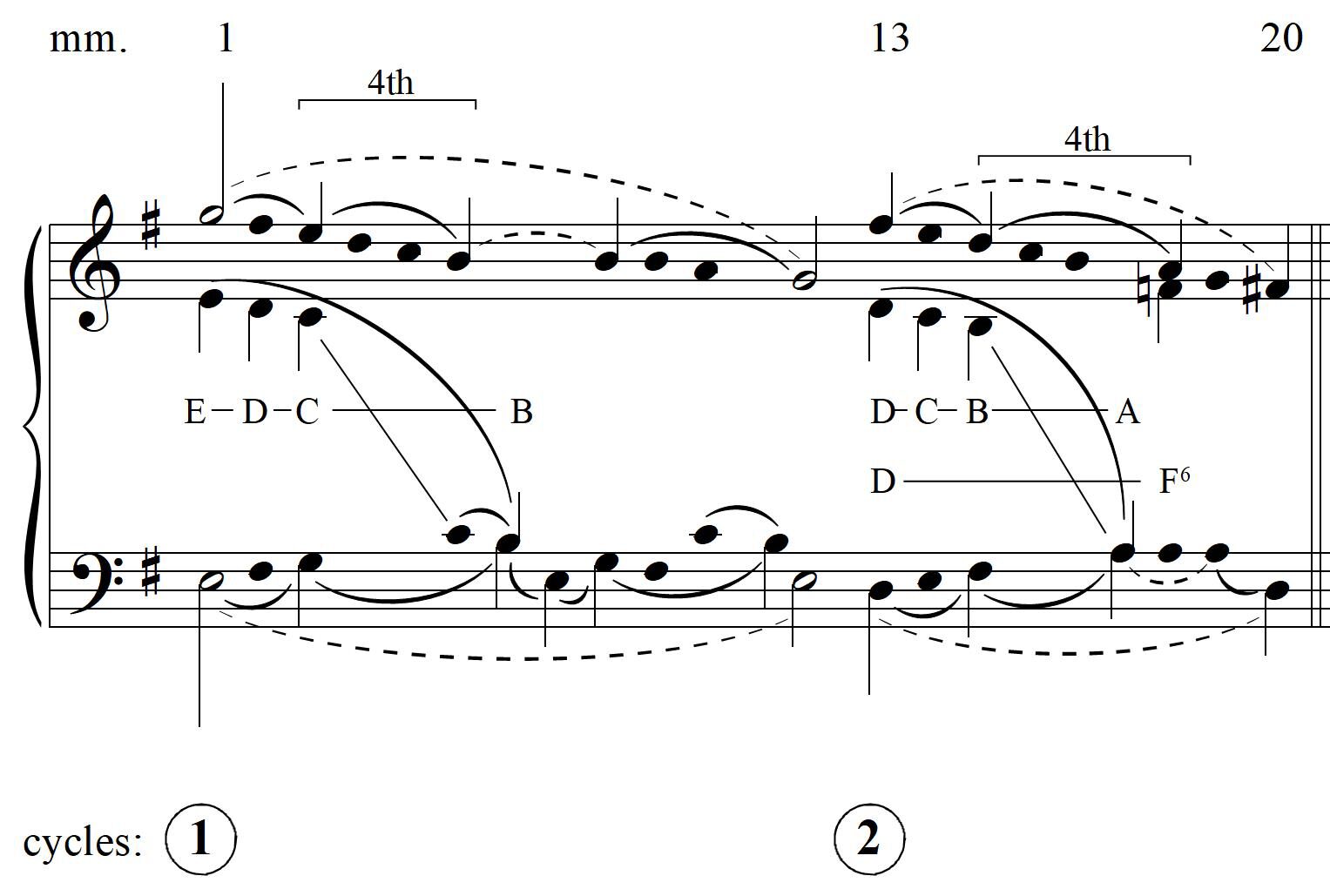
Related to the structural cycles in preludes from the WTC, the cyclic divisions in Example 9 are determined by the conclusion of the first octave descent in m. 12 where the coupling of $$\hat{3}$$ is executed. This coupling is a linear trait shared between the E-minor preludes of Shostakovich and Bach, where the octave transfer of G5–G4 is featured in their first cycles (compare mm. 1–12 of Example 9 with mm. 1–11 of Example 8c). The prolongational span formed by the octave descent reproduces a typical linear development in Baroque preludes; this serves as an access point for Schenkerian methodologies (Renwick 1995, 11–15). In the second cycle, the octave descent beginning on $$\hat{2}$$ echoes the contrapuntal events of mm. 1–12 in D major. The middleground in Example 9 associates cycle one with melodic $$\hat{3}$$ and cycle two with $$\hat{2}$$, highlighting the large-scale tenths formed between the bass and melody at the start of each cycle (E–G stepping down to D–F$$\sharp$$). The harmonic plane is further lowered in m. 23 when the D in the bass slips to D$$\flat$$, chromatically displacing the previous D-major passage into a region of D$$\flat$$ major (see Example 10). A contrapuntal D–F6 in mm. 13–17 prefigures the chromatic displacement with $$\flat\hat{2}$$. This contrapuntal motion is repeated in an intensified and condensed version in mm. 23–25 (D$$\flat$$–F6) where the localized shadow tonality elicits a descending fourth that starts on E$$\flat$$ instead of E$$\natural$$ (in m. 26).16 The modal lowering of the descending fourth as a reaction to the bass’s $$\flat\hat{7}$$ produces a chromatic extension of the motive. At deeper levels of middleground structure, however, the shift to D$$\flat$$ major in m. 23 is also symptomatic of motivic confirmation. Example 10 demonstrates how the bass line in mm. 1–28 is a chromatic enlargement of the descending fourth, moving from E in the first cycle to D–D$$\flat$$–C–B in the second cycle. From a broader linear perspective, the bass-line shift to D$$\flat$$ in m. 23 is observed as an instance of passing rather than a harmonic arrival point. A prolongational rendering of the prelude’s harmonic structure by the descending fourth also contributes to a more organic and unified representation of the music.
Retaining lowered elements from the chromatic displacement at m. 23, the closing section of cycle two (mm. 30–38) presents a functional complication when shifting from E minor to A$$\flat$$ major in mm. 30–31 (see Example 11). These key areas represent a hexatonic relationship generated by double mixture and deeper contrapuntal processes. A transformational interpretation of this chromatic shift in Example 12 also illustrates how each member of the initial minor triad moves one semitone to produce its hexatonic pole.
Studies of transformational expansions have contextualized chromatic passages within broader tonal fields. The progression from i to $$\sharp$$III in m. 31 functions in a similar way to progressions that feature hexatonic poles in Francis Poulenc’s music. David Heetderks (2015, 182–185) notes that $$\sharp$$III forms a hexatonic relationship with a minor tonic in Poulenc’s mature music and can be positioned within a phrase that leads toward an authentic cadence (i–$$\sharp$$III [HxP]–V7–i).17 In mm. 29–36 of Shostakovich’s Prelude no. 4, the modal lowering of the melodic descending fourth (E–E$$\flat$$) and the harmonic shift from i–$$\sharp$$III (enharmonic) that supports it initiate a progression with a trajectory toward the dominant. Example 13 clarifies that a final chromatic extension of the descending fourth in m. 29 invites an extended hexatonic region when the melodic E is lowered to E$$\flat$$.
The final cadence at m. 38 (and the following coda) seizes $$\hat{3}$$ as the structural melodic tone (see Example 13). In parentheses, melodic half steps G–F$$\sharp$$–F$$\natural$$–E project the vestige of an Urlinie in mm. 1–29, but this descent does not exemplify the highest degree of linear movement; rather, it designates middleground motion into an inner voice. At deeper levels, $$\hat{3}$$ is coupled over the span of mm. 1–38, retaining a static, or frozen, Urlinie.18 In m. 37, $$\hat{3}$$ is targeted by F$$\sharp$$ and A$$\flat$$ while the dominant is intensified by the lowering of its chordal seventh. The A$$\flat$$s that pervade the following coda harmonically resonate with the previously displaced key areas, D$$\flat$$ major and A$$\flat$$ major. Example 13 illustrates how $$\hat{3}$$ is coupled over lowered harmonic areas that support the chromatic variants of the octave descent and the parenthetical Urlinie. Although Prelude no. 4 explores distantly related harmonic areas at local levels, prolongational analysis expresses how each cycle contributes to the linear composing-out of the E-minor triad and imitates the techniques of preludes in the WTC. Shostakovich’s motivic parallelisms also saturate several dimensions of musical structure and emulate the compositional resourcefulness of Baroque literature.
3. Prelude No. 13 in F$$\sharp$$ Major, Op. 87
Perhaps the most customary linear designs in this study are featured in the following analysis of Prelude no. 13 in F$$\sharp$$ major.19 As in Prelude no. 4, the second cycle of Prelude no. 13 chromatically lowers diatonic material from the first cycle. Shostakovich begins his second set of preludes and fugues by ruminating on a pastoral melody (see Example 15); however, the lowering of $$\hat{2}$$, $$\hat{3}$$, $$\hat{5}$$, and $$\hat{7}$$ in the second cycle distorts the nostalgic aesthetic established in mm. 1–12.20
Examples 16a and 16b trace the structural melodic descent from $$\hat{5}$$ and the fundamental bass line in mm. 1–39. Of the three preludes examined in this study, Prelude no. 13 exhibits the most orthodox expressions of tonal closure at the conclusion of its cycles. The ending of each cycle is pronounced by an authentic cadence and the melodic descent of a fifth (C$$\sharp$$–F$$\sharp$$). In each melodic descent, $$\hat{2}$$ appears in parentheses over the bass’s $$\hat{5}$$ in Examples 16a and 16b where different pitches substitute for G$$\sharp$$4 in the cadential formula.
The prominent $$\hat{6}$$–$$\hat{5}$$ gesture in the opening theme ($$\hat{6}$$ is marked with flags in Examples 16a and 16b) is the primary agent of the pastorale. It functions not only to animate the rhetorical nostalgia of the thematic voice, but it also serves as a progenitor of two structural events linked to the opening pastoral image. At the surface level, the $$\hat{6}$$–$$\hat{5}$$ manifests as a dyad within the cadence of each cycle, generating a post-tonal dissonant effect in both pre-dominant- and dominant- functioning harmonies. Example 17a depicts the melody in mm. 1–2, and Examples 17b and 17c show the two authentic cadences in mm. 12 and 39.
The progressions in Examples 17b and 17c are saturated by the nostalgia dyad (C$$\sharp$$–D$$\sharp$$). In m. 11, both the pre-dominant and dominant are intensified by pastoral imagery, whereas in m. 38 only the dominant is colored.21 It is also significant that the first cycle cadences rather apprehensively with a melodic leap from $$\hat{1}$$ to $$\hat{5}$$ and with a dominant that omits the leading tone. In mm. 38–39, however, the leading tone is included and the melodic fourth leap is reversed (C$$\sharp$$–F$$\sharp$$) to achieve a stronger sense of harmonic closure in the second cycle. The energetic vectors of these leaps are represented by curved arrows in mm. 11–12 and 38–39.
The second structural manifestation of the pastoral image integrates the $$\hat{6}$$–$$\hat{5}$$ gesture into broader linear expansions. Example 18 highlights the prominent descending fourth from F$$\sharp$$–C$$\sharp$$ in the theme of mm. 1–2, illuminating how the harmonic state of F$$\sharp$$ major is established through both stepwise and arpeggiating motions. It is important to note that the function of the Baroque prelude’s exordium is to introduce and secure a key area through the composing-out of the tonic triad. In preludes from the WTC, tonic states are attained in the opening measures or throughout their first cycles.22 As in Prelude no. 4, the descending fourth from $$\hat{1}$$–$$\hat{5}$$ emerges within local and global levels of musical structure. Example 19 tracks the middleground pathways of the descending fourth. Each cycle essentially composes out fourth motion in an inner voice before cadencing, thereby confirming the structural resemblance between cycles one and two.

While the descending fourth is structurally linked to the prelude’s cyclic spans, its most extensive elaboration is reserved for the coda (mm. 39–55). In mm. 45–46, Shostakovich presents a succession of major triads that are remotely related in the context of F$$\sharp$$ major (see Example 20). Neo-Riemannian labels are shown in Example 20 to contextualize harmonic shifts between F$$\sharp$$-major, D-major, F-major, and A-major triads in chromatic space.
While the harmonic progression is amenable to transformational analysis, Example 21 reveals how the passage motivically nests the descending fourth in an inner voice (see the asterisk in Example 21). Like the lowered versions of the descending fourth in Prelude no. 4, the altered descent (F$$\sharp$$–F$$\natural$$–E$$\natural$$–D$$\sharp$$–C$$\sharp$$) in mm. 45–47 generates post-tonal harmonies that are distantly related at the surface level. The chromatic version is significant in that it preserves the whole step between D$$\sharp$$–C$$\sharp$$, the figurative symbol of the pastorale, amidst the triadic post-tonal variation of nearly every other scale degree in the passage. Beyond the chromatic turmoil of the surface, Example 21 illustrates how middleground I–IV–I elaboration in mm. 44–49 conveys structural prolongation over the span of this passage (typical of standard codas), encapsulating the chromatic area within a broader tonal expanse.23 The descending fourths at the end of the coda are confirmed in multiple registers and achieve a valedictory appearance starting on F$$\sharp$$6 in m. 52. Motivic overlap with registral variety forms an organically saturated coda and a prelude that is structurally unified by both linear and vertical amplifications of the pastoral $$\hat{6}$$–$$\hat{5}$$ theme.
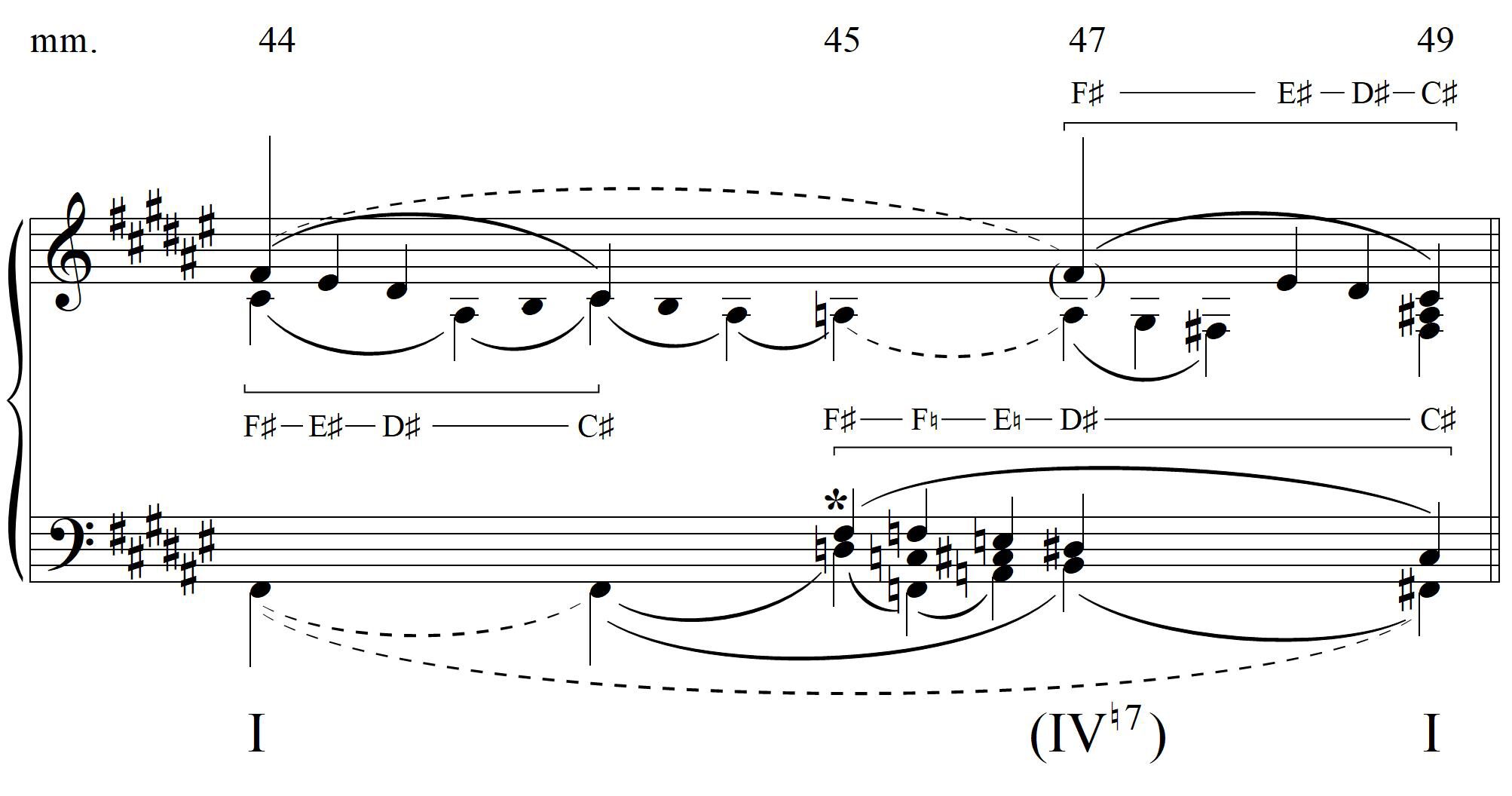
4. Prelude No. 22 in G Minor, Op. 87
As in Prelude nos. 4 and 13, the second cycle of Prelude no. 22 in G minor (m. 45) chromatically alters material from its first cycle and develops a linear motive that influences harmonic progressions (see Example 22 for cyclic divisions of Prelude no. 22). Its first cycle, however, does not expand on diatonic harmonies but includes triadic post-tonal chords such as a chromatic submediant E$$\flat$$ minor (mm. 5–7) and a hexatonic pole B major (mm. 16–19) when the G-minor tonic is not being sustained.24 This cycle is also more expansive than the initial cycles of Prelude nos. 4 and 13, as well as preludes in the WTC, spanning forty-four measures. While E$$\flat$$-minor and B-major harmonies are distantly related to G minor and are produced through the lowering of the G-minor scale, they function as analogues to contrapuntal neighboring motions through the processes of secondary and double mixture.
Example 23 summarizes the middleground of the first cycle (mm. 1–45). The enharmonic treatment of F$$\sharp$$ in m. 3 and G$$\flat$$ in m. 4 is maintained in both cycles, prolonging the G-minor tonic along with $$\hat{5}$$–$$\hat{6}$$–$$\hat{5}$$ contrapuntal motions in an upper voice. In mm. 8–20, the figures interpret C-major and B-major triads as chromatic adjustments of a neighboring subdominant. What would have been a conventional tonal idiom (the subdominant prolonging tonic) incorporates triadic post-tonal harmonies––C major introduces $$\natural\hat{6}$$ and the hexatonic pole B major lowers each pitch of that triad by one semitone.25 Although its surface harmonies appear distantly related, Prelude no. 22 is immobile at deeper levels of structure. In mm. 20–45, the $$\hat{5}$$–$$\hat{6}$$–$$\hat{5}$$ idiom is extended by a strain of linear chromaticism, and the independent motion of the upper voices is represented by the staggering of figures in Example 23. While the bass becomes more active starting in m. 35, its third-descent to C takes place within the broader expansion of tonic.
It is only in the second cycle (mm. 45–84) that structural bass-line motion is observed (see Example 24). In m. 67, the bass’s low arrival on D1 places registral emphasis on a cadential six-four that avoids resolution to a dominant triad.26 The middleground in Example 25 illustrates how the structural dominant in m. 67 does not persuade $$\hat{3}$$ in the melody to descend to $$\hat{2}$$. Instead, the bass and inner voices meander within the dominant region in search of a pathway back to tonic, shown in the figures in mm. 67–84. Without a departure from $$\hat{3}$$ in the melody, the prelude expresses a static Urlinie.
Within the restricted middleground structure of each cycle, the upper voice traces a series of recurring chromatic threads comprised of B$$\flat$$, C, and an enharmonic C$$\flat$$ that participate in neighboring activity above the bass. In mm. 20–35, a rising chromatic line is initiated in an inner voice (marked with stems and tenor annotations in Example 25) that is then transferred to the upper voice in m. 33. Although the recurring line involves notes B$$\flat$$, C, and C$$\flat$$, the occurrence of A$$\natural$$ at closer structural levels beckons the question of whether the BACH motif is covertly embedded into the prelude’s chromatic framework. Examples 1a and 1b illustrated various ways that Shostakovich’s Twenty-Four Preludes and Fugues incorporate features of preludes and fugues from the WTC, and Shostakovich was certainly no stranger to monograms, quotations, or intertextual references.27 While the chromatic neighbors in Example 25 are produced by the lowering of the G-minor scale, the BACH motif is rendered symptomatically at levels closer to the musical surface.
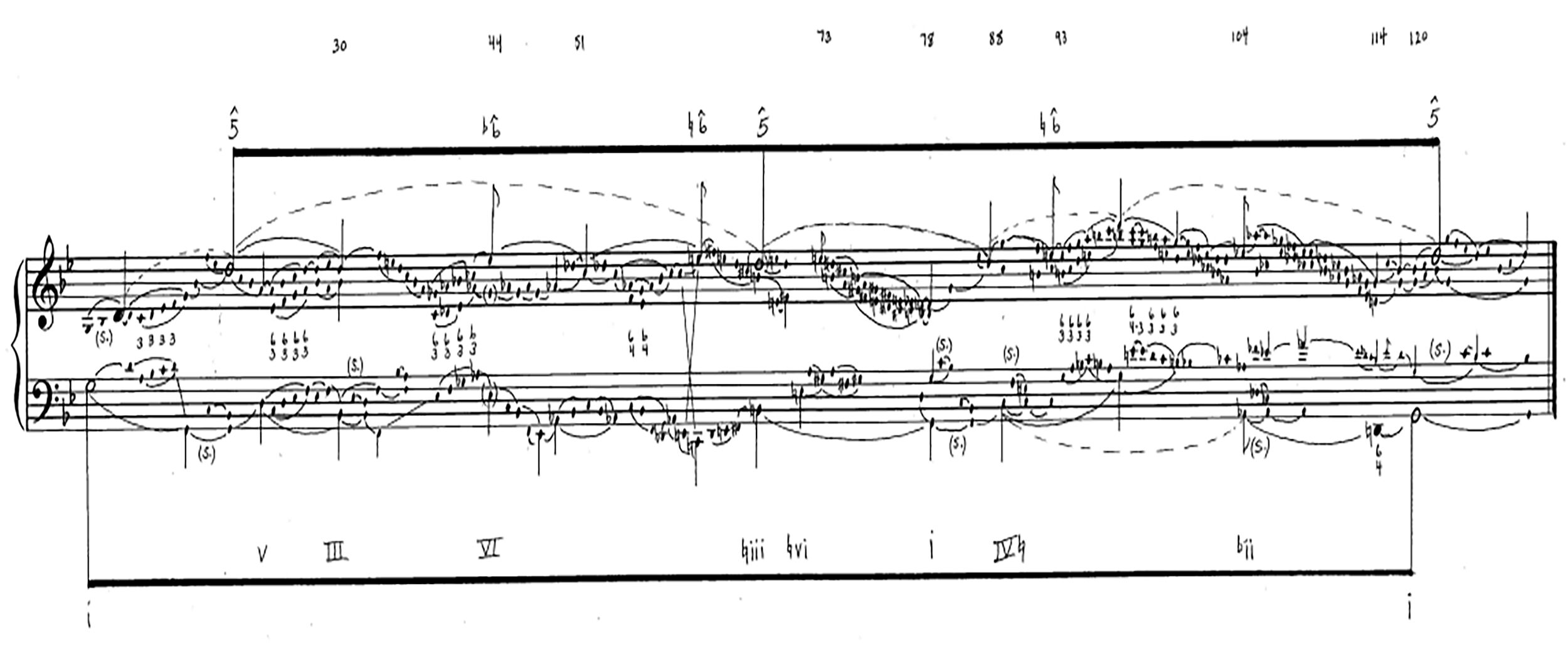
The structural immobilization of Prelude no. 22, as in Prelude no. 4, is the result of large-scale melodic inactivity. In each of the piece’s two cycles, tonic expansion prevents structural arpeggiation or the appearance of a dominant harmony. It is significant that Fugue no. 22 in G minor, the fugue paired with this prelude, also generates a static Urlinie (see Example 26; Marlowe 2013, 171). Although the fugue’s Urlinie retains $$\hat{5}$$ instead of $$\hat{3}$$, the highest levels of structure in both middleground interpretations render prolongational stasis through $$\hat{5}$$–$$\hat{6}$$–$$\hat{5}$$ motions. Additionally, the fugue echoes the unresolved cadential six-four in the prelude, denying structural resolution in its harmonic dimensions and in the structural melody. In the prelude, recurring $$\hat{5}$$–$$\hat{6}$$–$$\hat{5}$$ and $$\hat{3}$$–$$\hat{4}$$–$$\hat{3}$$ neighboring motions and their chromatic counterparts, combined with the static middleground, establish a petrified musical exterior.28
Conclusion
This analysis cultivates a space for exploring how Shostakovich’s music expresses tonality. Harmonic surface tension is generated through modal lowering, chromaticism, and triadic post-tonal passages that intensify underlying tonal progressions and prolongations. Middleground examination of Prelude nos. 4, 13, and 22 from the Twenty-Four Preludes and Fugues illustrates how Shostakovich’s synthesis of orthodox compositional practice and triadic post-tonality engages with structural directedness and expansion, rendering models for structural hearing comparable to those in the Bach-to-Brahms tradition. This study also promotes a methodological pluralism by constructing dialogue between varied approaches to Shostakovich’s music, including prolongational methodologies, neo-Riemannian theory, and Russian modal-scalar perspectives. Shostakovich expands on contrapuntal voice-leading principles without dismantling the functional roles of impacted harmonies. This reconstructed vision of tonality resonates with Matthew Brown’s impressions of the outer limits of Schenker’s theory of harmonic relations. He writes, “For Schenker, the tonal universe encompasses an almost limitless range of harmonic possibilities, restricted only by the rules of voice leading” (Brown 1986, 25). This investigation provides a foundation for linear approaches to Shostakovich’s music, but there are many passages amenable to prolongational techniques that remain to be explored. Further examination of tonal activity in Shostakovich’s works would reveal additional structural connections and shed light on significant aspects of his compositional process.
References
Baker, James M. 1983. “Schenkerian Analysis and Post-Tonal Music.” In Aspects of Schenkerian Theory, edited by David Beach, 153–186. New Haven: Yale University Press.
———. 1990. “Voice Leading in Post-Tonal Music: Suggestions for Extending Schenker’s Theory.” Music Analysis 9 (2): 177–200.
Bass, Richard. 1988. “Prokofiev’s Technique of Chromatic Displacement.” Music Analysis 7 (2): 197–214.
Bakulina, Ellen. 2015. “Tonality and Mutability in Rachmaninoff’s All-Night Vigil, Movement 12.” Journal of Music Theory 59 (1): 63–97.
———. 2018. “Proto-Harmony and the Problem of Tonal Centricity in Rachmaninoff’s All-Night Vigil.” Intégral 32: 15–36.
Brown, Matthew. 1986. “The Diatonic and the Chromatic in Schenker’s Theory of Harmonic Relations.” Journal of Music Theory 30 (1): 1–33.
———. 1993. “Tonality and Form in Debussy’s Prélude à ‘L’Après-midi d’un faune.’” Music Theory Spectrum 15 (2): 127–143.
———. 2005. Explaining Tonality: Schenkerian Theory and Beyond. Rochester: University of Rochester Press.
Carpenter, Ellon. 1995. “Russian Theorists on Modality in Shostakovich’s Music.” In Shostakovich Studies, edited by David Fanning, 76–112. New York: Cambridge University Press.
Cohn, Richard. 1998. “Introduction to Neo-Riemannian Theory: A Survey and a Historical Perspective.” Journal of Music Theory 42 (2): 167–180.
———. 2004. “Uncanny Resemblances: Tonal Signification in the Freudian Age.” Journal of the American Musicological Society 57 (2): 285–324.
Ewell, Philip. 2019. “On the Russian Concept of Lād, 1830–1945.” Music Theory Online 25 (4). https://www.mtosmt.org/issues/mto.19.25.4/mto.19.25.4.ewell.html.
———. 2020. “Harmonic Functionalism in Russian Music Theory: A Primer.” Theoria 26: 31–84.
Fanning, David. 1989. The Breath of the Symphonist: Shostakovich’s Tenth. London: Routledge.
———. 1995. “Introduction. Talking about Eggs: Musicology and Shostakovich.” In Shostakovich Studies, edited by David Fanning, 1–16. New York: Cambridge University Press.
———. 2010. “Shostakovich and Structural Hearing.” In Shostakovich Studies 2, edited by Pauline Fairclough, 77–99. New York: Cambridge University Press.
Fay, Laurel E. 2000. Shostakovich: A Life. New York: Oxford University Press.
Forrest, David. 2010. “Prolongation in the Choral Music of Benjamin Britten.” Music Theory Spectrum 32 (1): 1–25.
Goldenberg, Yosef. 2007. “Schenkerian Voice-Leading and Neo-Riemannian Operations: Analytical Integration without Theoretical Reconciliation.” Journal of Schenkerian Studies 2: 65–86.
Harrison, Daniel. 2016. Pieces of Tradition: An Analysis of Contemporary Tonal Music. New York: Oxford University Press.
Heetderks, David. 2015. “From Uncanny to Marvelous: Poulenc’s Hexatonic Pole.” Theory and Practice 40: 177–204.
Henderson, Lyn. 2000. “Shostakovich and the Passacaglia: Old Grounds or New?” The Musical Times 141 (1870): 53–60.
Hussey, William. 2003. “Triadic Post-Tonality and Linear Chromaticism in the Music of Dmitri Shostakovich.” Music Theory Online 9 (1). http://www.mtosmt.org/issues/mto.03.9.1/mto.03.9.1.hussey.html.
Jackson, Timothy. 2024. “‘A True and Genuine Music’: Berg’s Linear Counterpoint.” Rivista di Analisi e Teoria Musicale 30 (1): 7–91.
Kuhn, Judith. 2010. Shostakovich in Dialogue: Form, Imagery and Ideas in Quartets 1–7. Burlington, VT: Ashgate.
Lerdahl, Fred. 1989. “Atonal Prolongational Structure.” Contemporary Music Review 4 (1): 65–87.
Lester, Joel. 1970. “A Theory of Atonal Prolongations as Used in an Analysis of the Serenade Op. 24 by Arnold Schoenberg.” PhD diss., Princeton University.
———. 1999. Bach’s Works for Solo Violin. New York: Oxford University Press.
Marlowe, Sarah Rose. 2013. “Fugue in Context: A Schenkerian Approach to Select Works by J.S. Bach and Dmitri Shostakovich.” PhD diss., University of Rochester.
McCreless, Patrick. 2009. “Dmitri Shostakovich: The String Quartets.” In Intimate Voices: The Twentieth-Century String Quartet.Vol. 2, Shostakovich to the Avant-Garde, edited by Evan Jones, 3–40. Rochester: University of Rochester Press.
———. 2010. “Shostakovich’s Politics of D Minor and Its Neighbours, 1931–1949.” In Shostakovich Studies 2, edited by Pauline Fairclough, 121–189. New York: Cambridge University Press.
Ottaway, Hugh. 1975. “Looking Again at Shostakovich 4.” Tempo, no.115: 14–24.
Renwick, William. 1995. Analyzing Fugue: A Schenkerian Approach. New York: Pendragon Press.
Rusch, René. 2012–13. “Schenkerian Theory, Neo-Riemannian Theory and Late Schubert: A Lesson from Tovey.” Journal of the Society for Musicology in Ireland 8: 3–20.
Salzer, Felix. 1952. Structural Hearing: Tonal Coherence in Music. New York: Dover Publications.
Schenker, Heinrich. 1977. Free Composition. Edited and translated by Ernst Oster. Hillsdale, NY: Pendragon Press.
———. 1987. Counterpoint. Vol. 1, translated by John Rothgeb and Jurgen Thym. New York: Schirmer.
Segall, Christopher. 2019. “Prolongational Analysis Without Beams and Slurs: A View from Russian Music Theory.” Journal of Schenkerian Studies 12: 183–188.
Straus, Joseph. 1987. “The Problem of Prolongation in Post-Tonal Music.” Journal of Music Theory 31 (1): 1–21.
Taruskin, Richard. 2008. On Russian Music. Berkeley: University of California Press. Teo, Yvonne. 2018. “Hybridising the Schenkerian Method: A Selected Section of the First Movement of Paul Hindemith’s Piano Sonata No. 1 as a Case Study.” Context 43: 29–46.
Notes
- Ellen Bakulina (2015, 2018) has also contributed significant prolongational approaches to the music of Rachmaninoff, another Russian composer whose music, like Shostakovich’s, exhibits tonal, modal, and post-tonal properties.
- The processes of simple, secondary, and double mixture contextualize highly chromatic passages within tonal fields (Brown 2005, 44). In combination with counterpoint that generates a harmonic state or motion toward a tonal goal, these processes aid in the linear interpretations of both small- and large-scale progressions featuring distantly related triads. While some traditional theorists and Schenker himself have imposed limitations on prolongational methodologies to music outside the Bach-to-Brahms canon (Straus 1987), this paper adopts a less restrictive mentality on linear possibilities that resonates with the works of Felix Salzer (1952), James Baker (1983, 1990), Ellen Bakulina (2015, 2018), Matthew Brown (1986, 1993), Sarah Marlowe (2013), David Fanning (2010), Joel Lester (1970), Fred Lerdahl (1989), David Forrest (2010), and Timothy Jackson (2024).
- The term triadic post-tonality is derived from Richard Cohn (1998, 168). While Russian studies imply that the core of Shostakovich’s writing is diatonic, passages featuring chromatically related triads often do not exhibit standard functional relationships but showcase stepwise voice leading that is characteristic of triadic post-tonal chord changes.
- The editorial “Muddle Instead of Music” appeared in Pravda on 28 January 1936. Shostakovich was subjected to an additional attack in Pravda on February 6 via the editorial “Balletic Falsity” for the ballet The Limpid Stream. These unsigned editorials are believed to be penned (at least partially) by Stalin—the term “muddle” was a common Stalinist utterance flung toward “formalist” art, literature, and music that undermined nationalist propaganda and reflected cultural depravity. Stalin is noted to have attended a performance of Lady Macbeth of the Mtsensk District at the Bolshoy Theater on January 26, two days before “Muddle Instead of Music” was distributed (Fay 2000, 84–85).
- While Bach orders his preludes and fugues chromatically, first major, then minor, with each new tonic raised a half step from the previous tonic, Chopin and Shostakovich order theirs according to the circle of fifths (major, relative minor, then the next major key on the circle of fifths, its relative minor, etc.).
- In the music of Francis Poulenc, David Heetderks (2015) discusses the passing and neighboring functions of hexatonic poles and their role within broader progressions that lead to cadences. His functional models can contextualize progressions in Shostakovich’s music, including an authentic cadence produced by i–HxP–V–i. Cohn (2004, 303–305) also analyzes hexatonic third-progressions in works by other composers as resulting through mixture processes.
- Triads related by major thirds and tritones are more closely related in chromatic space when measured by the semitone movements required to complete a transformation, whereas distances measured by root motion (on the circle of fifths) require more steps.
- It is not uncommon even in late nineteenth-century music to observe similar alterations of the vii$$^{\circ}$$7 chord, in which a portion of the chord is present (sometimes enharmonically) but other members are chromatically shifted.
- Yosef Goldenberg (2007, 60) provides a helpful table comparing Schenkerian and neo-Riemannian interpretations of diatonic and chromatic progressions where chordal roots are related by thirds, summarizing their interpretations through the processes of mixture or transformational operations.
- Dolzhansky’s modally derived scales result from the lowering of diatonic collections. He determined that Shostakovich’s modal language was based on the lowering of intervals from medieval modes, producing both entire scales and fragments of scales constructed on the alteration and blending of traditional modal materials. Dolzhansky explores how the technique of modal lowering forms double-lowered Phrygian and double-lowered Aeolian collections in Shostakovich’s music (Carpenter 1995, 77).
- Ewell (2019, 2020) expands further on nineteenth- and twentieth-century Russian concepts of modality, tonality, and function.
- An alternative approach to voice leading in Shostakovich’s music could adopt Daniel Harrison’s (2016, 82–88) curvilinear character types. Harrison’s K-lines, H-lines, and S-lines (after Kurth, Hindemith, and Schenker) could explicate the directionality of various step progressions in highly chromatic passages without necessarily connecting every pitch to an underlying tonal structure. This approach would be especially valuable to Shostakovich’s experimental works written between 1927–1936 that feature what Hugh Ottaway (1975) describes as “non-functional counterpoint.”
- This statement applies primarily to post-tonal works that feature linear counterpoint amenable to prolongational, transformational, and Russian modal-scalar approaches. For examples of analytical models that demonstrate the complementary relationship between Schenkerian and neo-Riemannian methodologies in common-practice music (the late music of Franz Schubert), see René Rusch (2012–13).
- Motivic confirmation describes both the operation and saturation of surface-level motives, figures, or linear gestures within deeper levels of musical structure.
- In her chapter on Russian theoretical approaches to Shostakovich’s music, Ellon Carpenter (1995, 112) writes that Russian modal theories have not focused on large-scale structures in Shostakovich’s music, calling for studies that penetrate beyond the musical surface and establish modal and tonal frameworks for entire pieces.
- Chromatically displaced passages may also be described as projecting a metaphorical shadow tonality. For examples of other chromatically displaced passages in twentieth-century Russian works by Sergei Prokofiev, Dmitry Kabalevsky, and Shostakovich, see Richard Bass (1988).
- HxP is an abbreviation for hexatonic pole.
- The coupling of $$\hat{3}$$ in mm. 1–38 is a structural augmentation of the salient surface-level octave descents associated with the Baroque prelude style.
- Prelude no. 13 is the only prelude of the three that exhibits a structural melodic progression to $$\hat{1}$$. Nevertheless, chromatic lowering produces post-tonal dissonant effects at the surface level.
- If this opening gesture were orchestrated, it is conceivable that the pastoral-sounding melody would be performed by a flute or oboe, similar to Frederick Delius’s Florida Suite, “Daybreak,” or Edvard Grieg’s “Morning Mood” from Peer Gynt.
- An alternative analysis of the harmonic progressions colored by the C$$\sharp$$–D$$\sharp$$ dyad would include the D$$\sharp$$ in the dominant harmony as a chordal ninth, reflecting an enriched harmony similar to those featured in the late-Romantic French and Spanish art songs of composers like Gabriel Fauré and Fernando Obradors.
- The octave coupling of $$\hat{3}$$ in a prelude’s first cycle can both establish and reinforce a tonic state, for example, as shown in the analyses in Examples 7–9.
- Example 21 also clarifies the melodic registral gap in the right hand created between F$$\sharp$$3 and E$$\sharp$$4 in m. 47. The F$$\sharp$$3 belongs to an inner voice, whereas the E$$\sharp$$4 is part of a separate descending fourth in the upper voice.
- The relationship between G minor and B major can be defined in hexatonic space as an H transformation. B major effectively prolongs the tonic via neighboring motions similar to the hexatonic expansion of tonic in mm. 1–4 of String Quartet no. 9 (see Examples 2–4b). Alternatively, Harrison’s (2016) H-lines could track the vectors of step-wise progressions in the inner and outer voices without hierarchical contextualization.
- B, D$$\sharp$$, and F$$\sharp$$ are enharmonically understood as C$$\flat$$, E$$\flat$$, and G$$\flat$$ in the figures.
- In m. 67, a rising scale in the left hand also overrides the expectation of the cadential six-four resolving to the dominant by passing through F$$\natural$$.
- See Lyn Henderson’s (2000, 55) observations of additional connections between Shostakovich’s Twenty-Four Preludes and Fugues and Bach’s WTC.
- For another example of a static Urlinie, see Salzer’s (1952, 248–249) analysis of Hindemith’s Piano Sonata no. 2 (1936).
